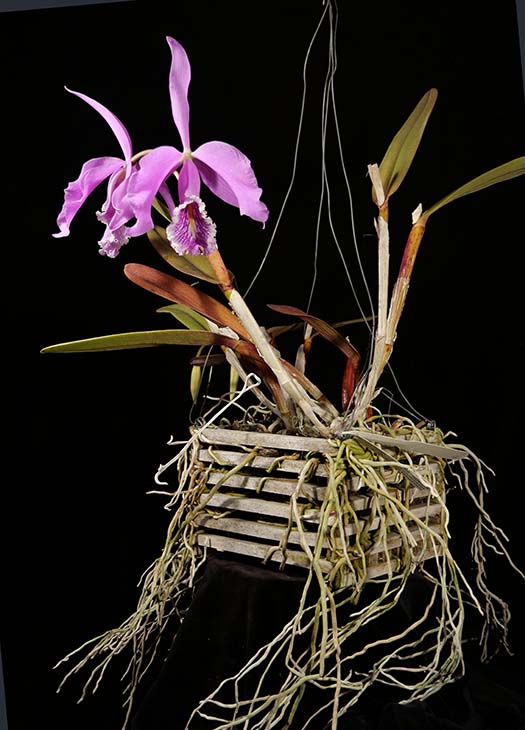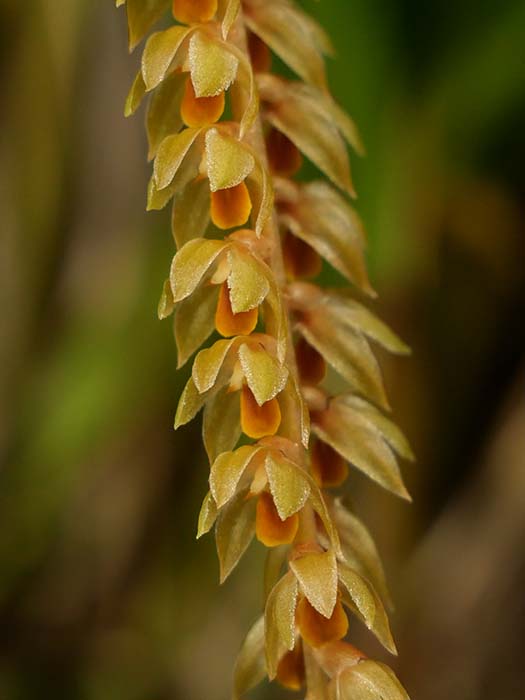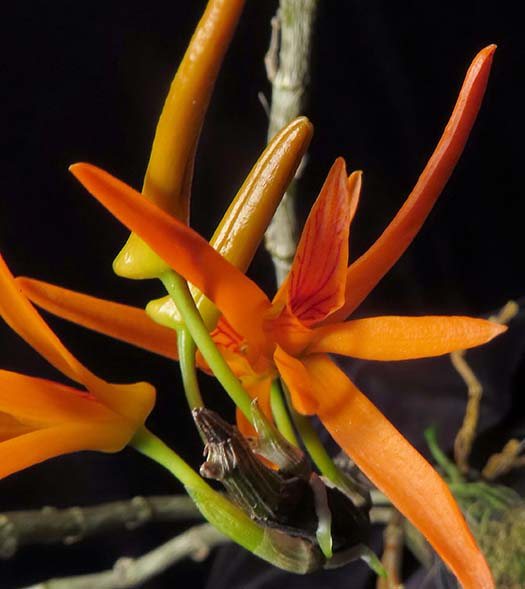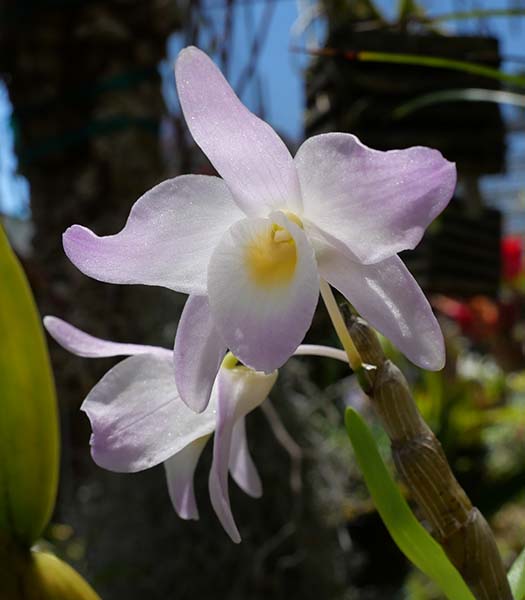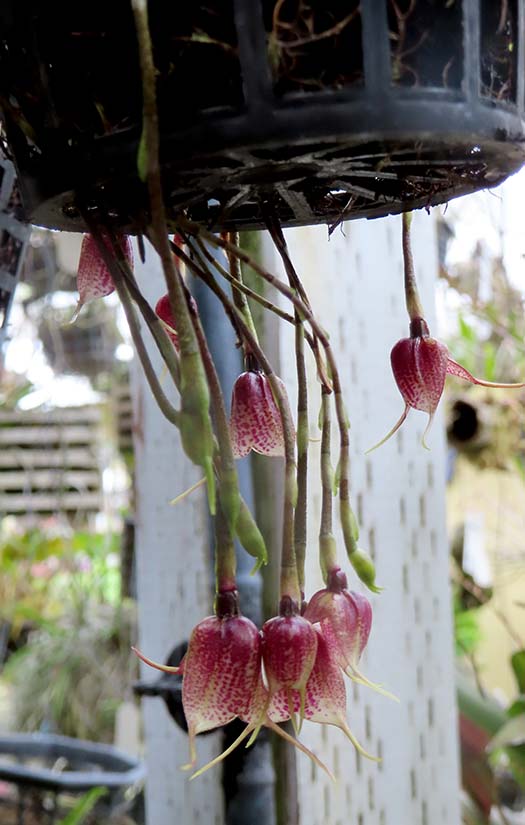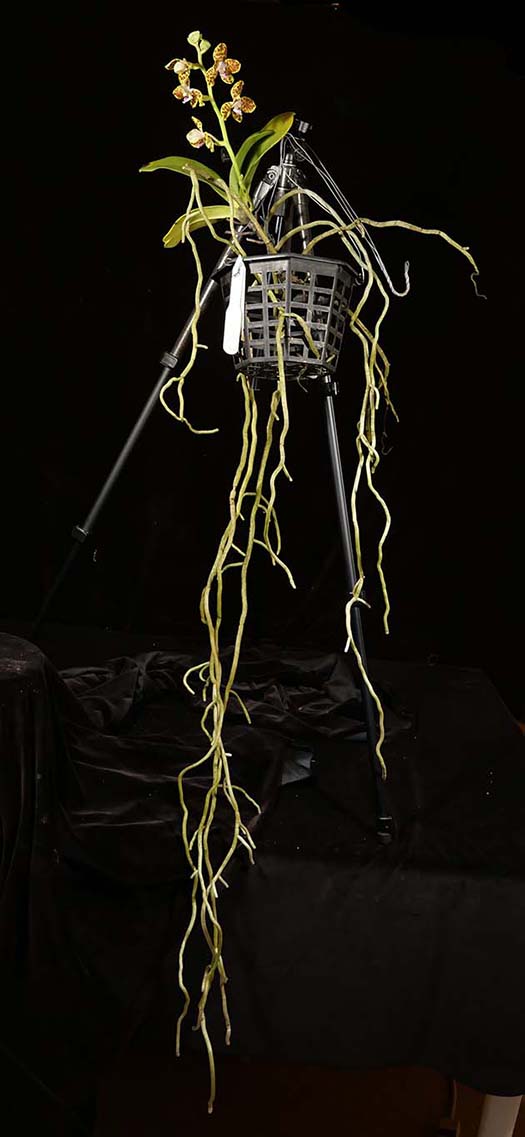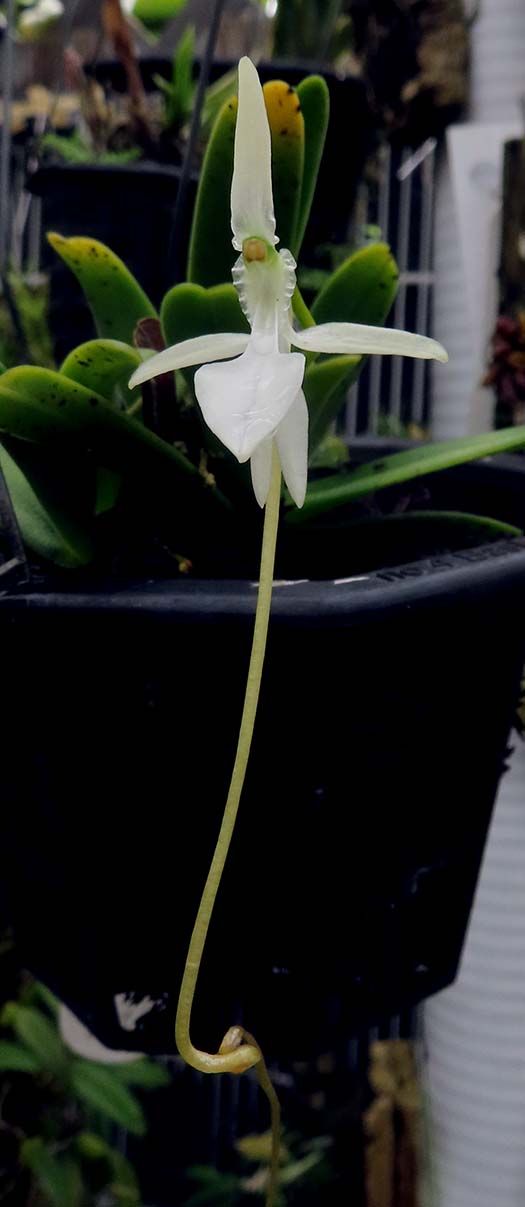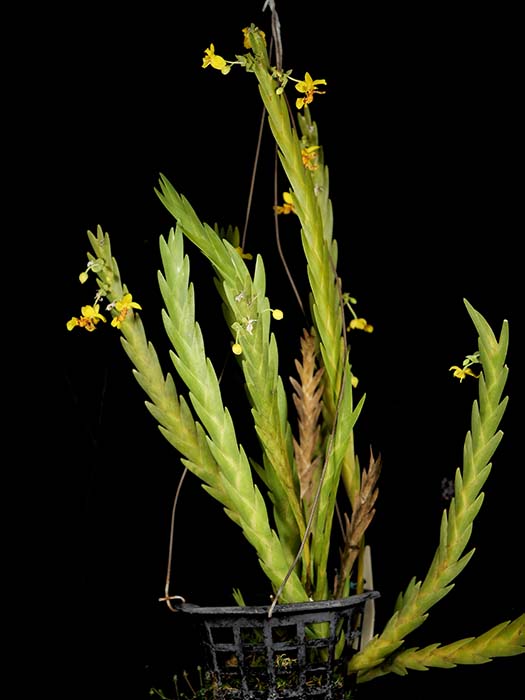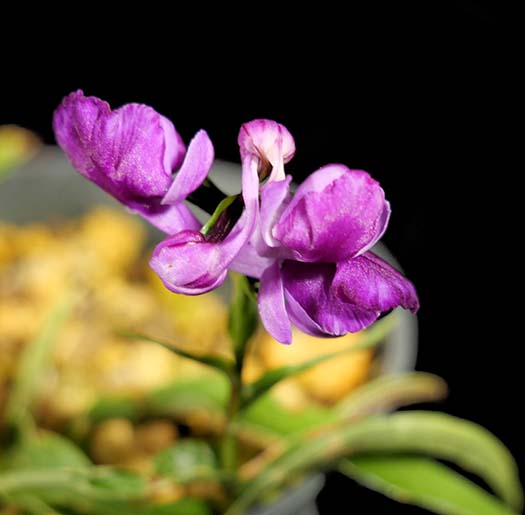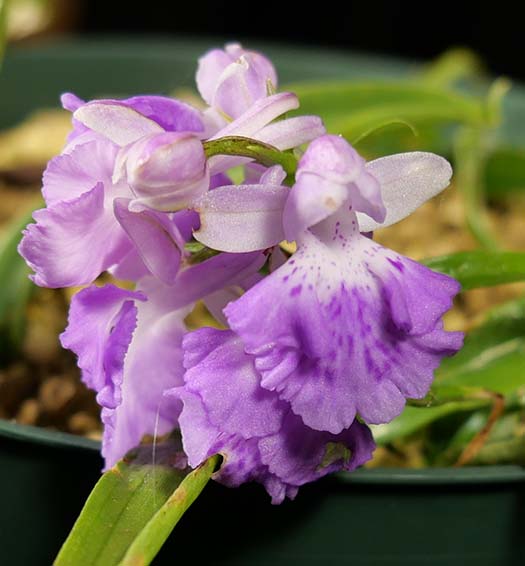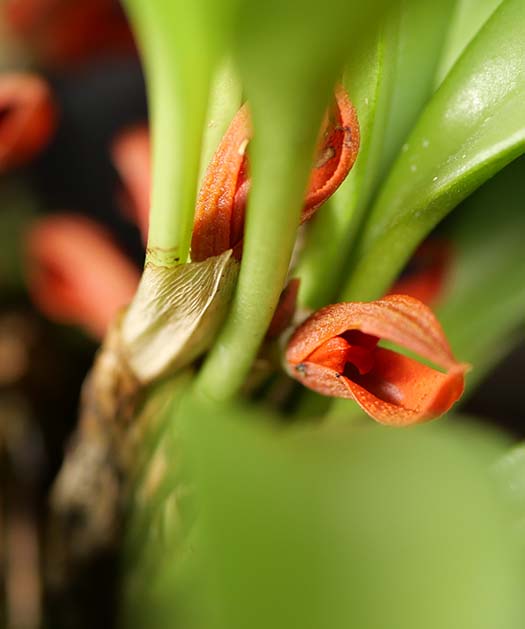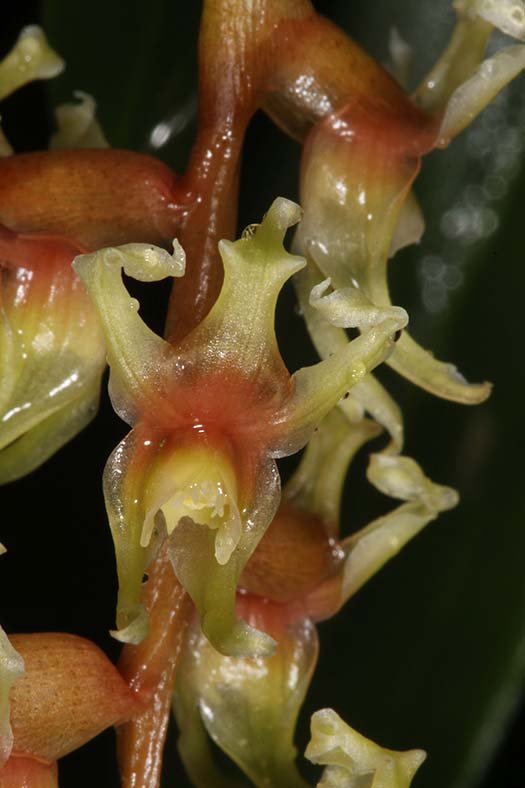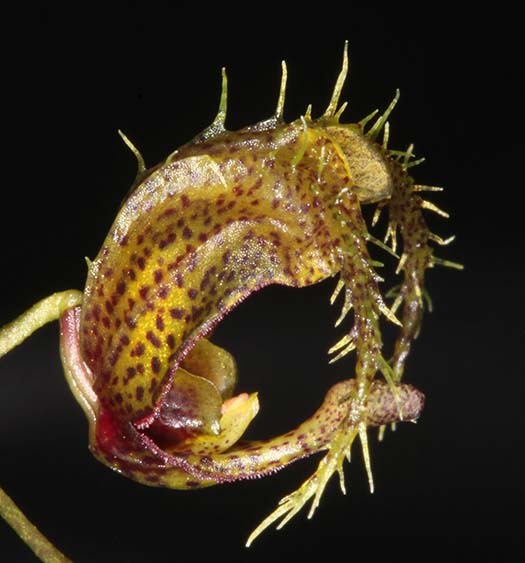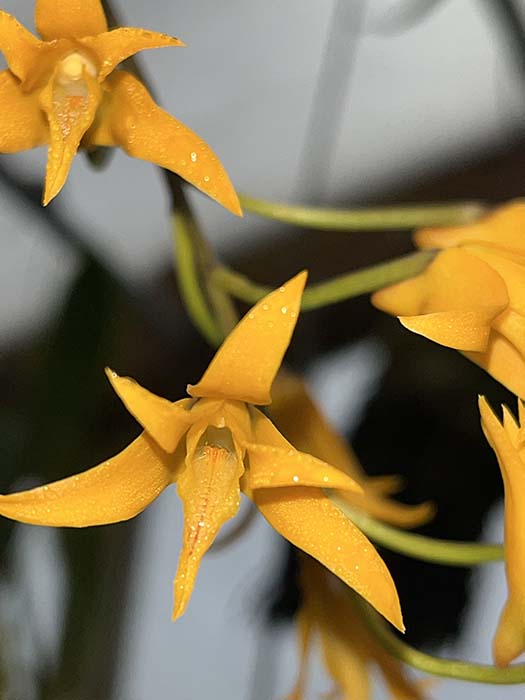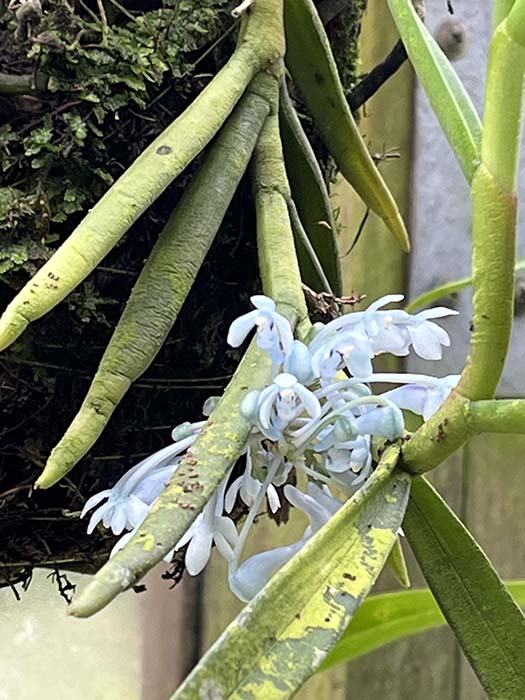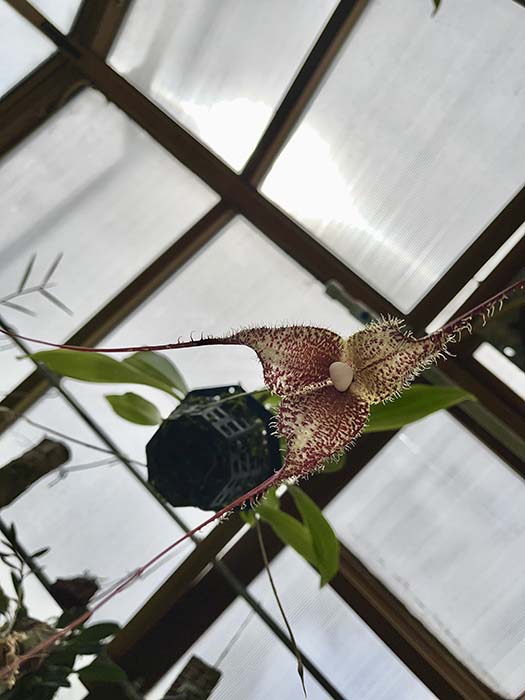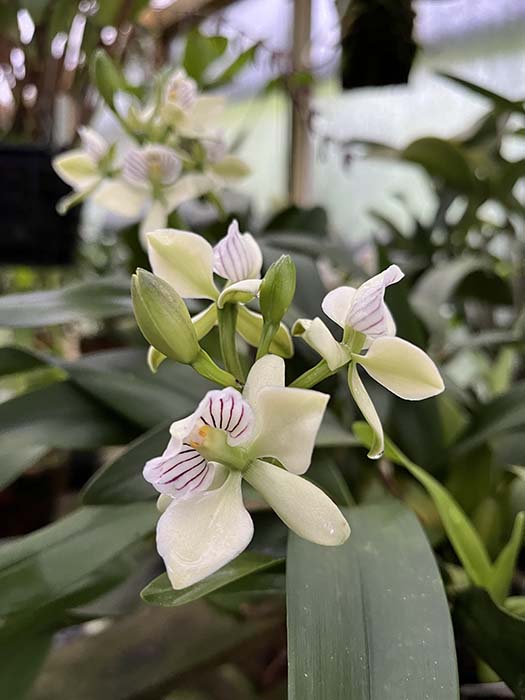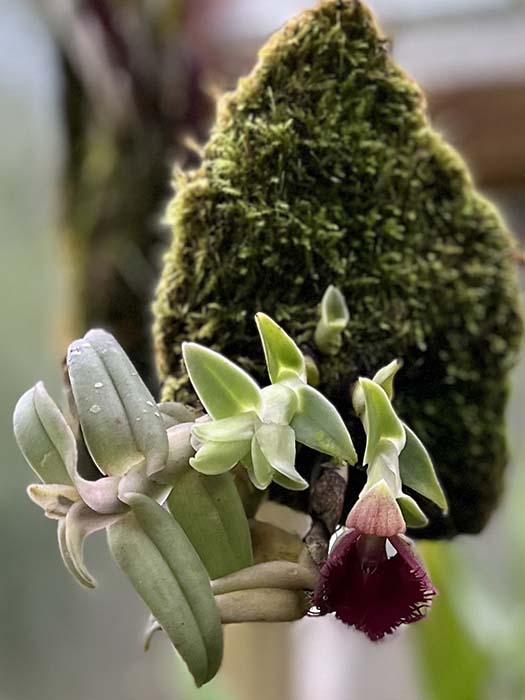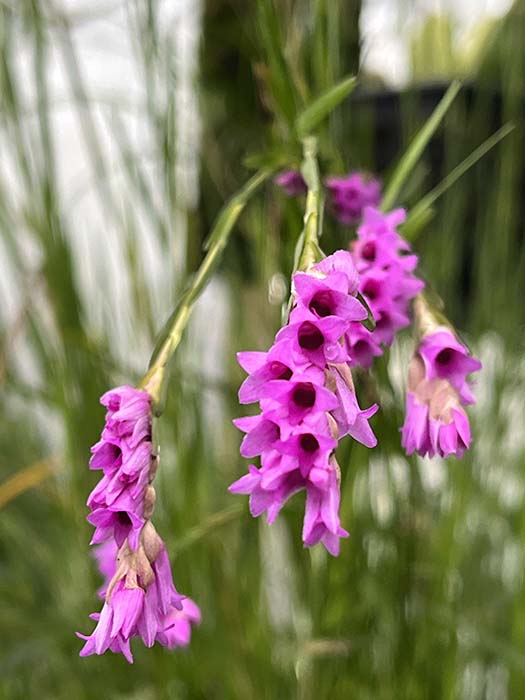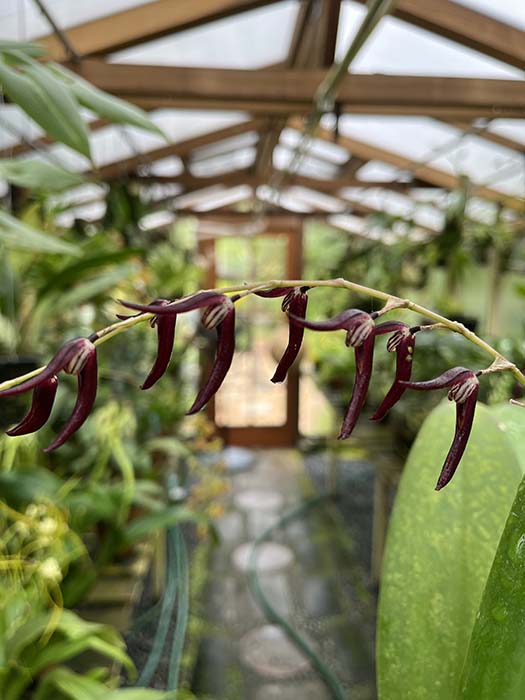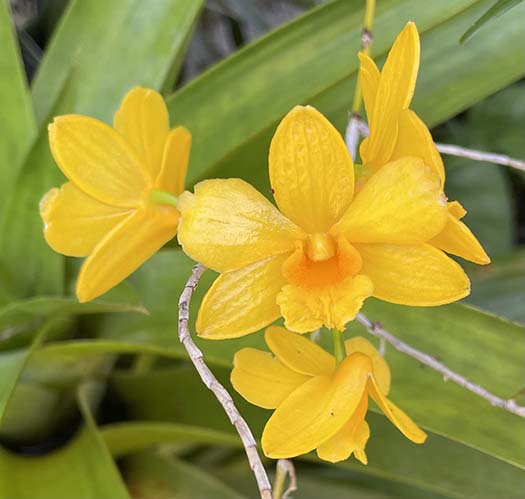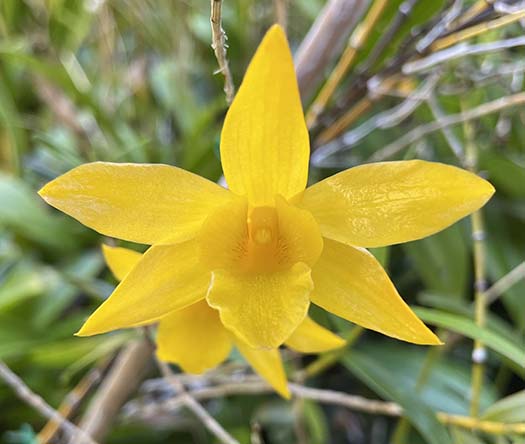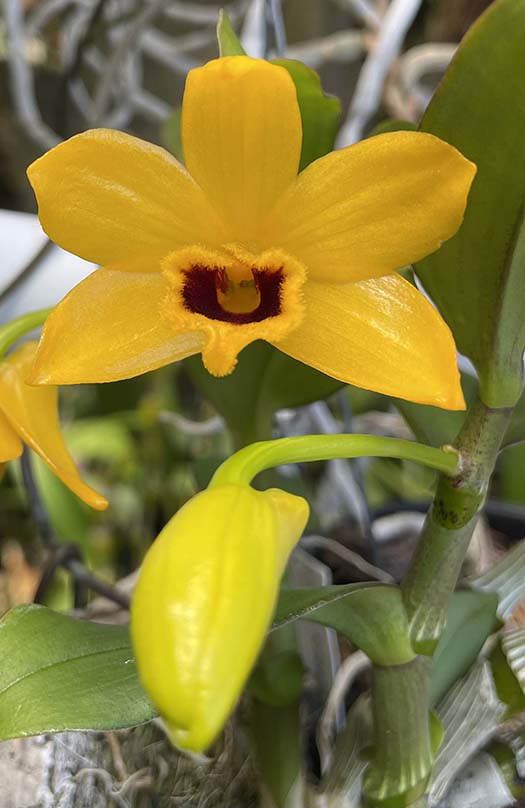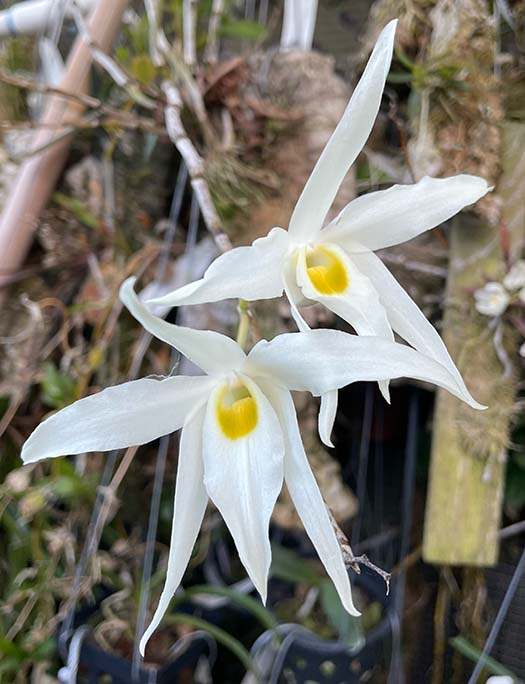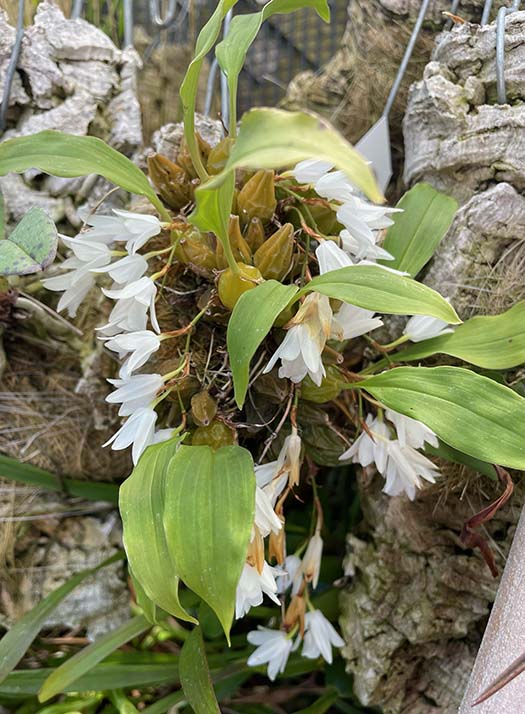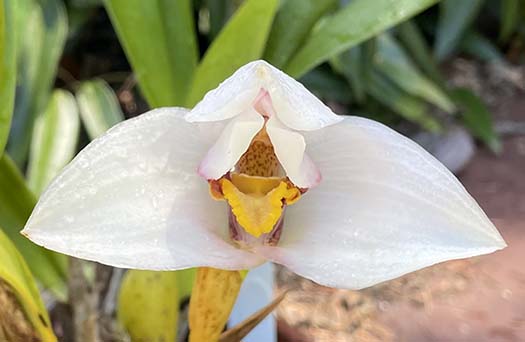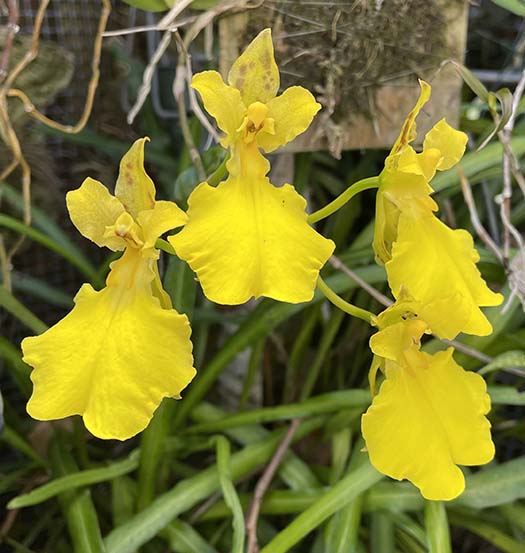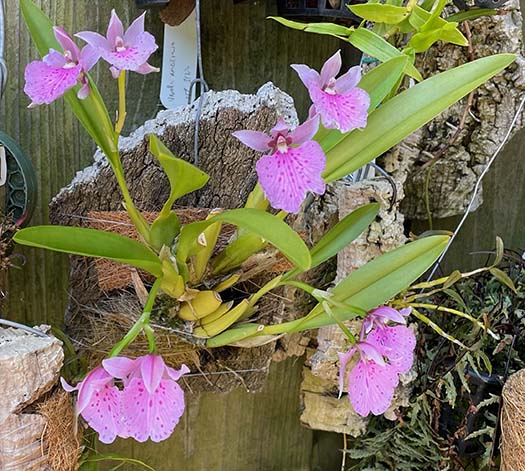July 2024
From Scott McGregor:All orchids grown outdoors, coastal southern California |
|
Capenemia superflua (uliginosa)Can be tricky, but grows well for me mounted and bright. The crystalline flowers are tiny (1/8 inch) but abundant and very fragrant. |
|
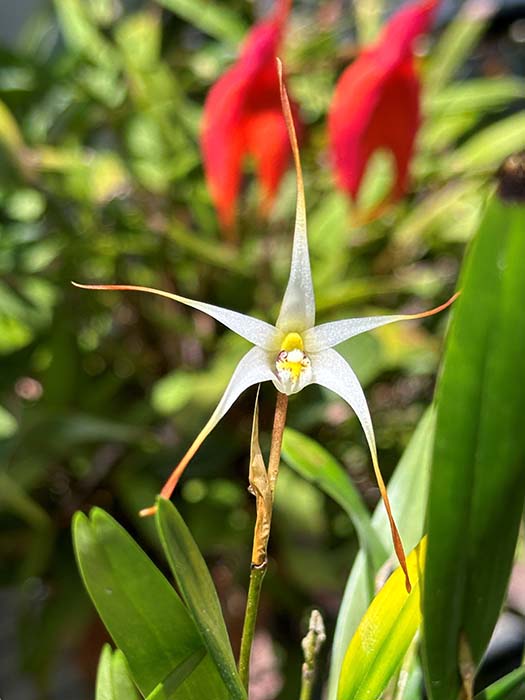
Diplocaulobium aratriferum 'Watermelon Rind'The flowers last for only part of a day, but the intense watermelon scent is remarkable, and the plant reblooms many times per year in case you miss it. |
|
Domingoa (Nageliella) angustifoliaI wouldn’t call the flowers pretty, but they open like fireworks on long wiry stems and rebloom repeatedly off the old spikes (don’t cut). |
|
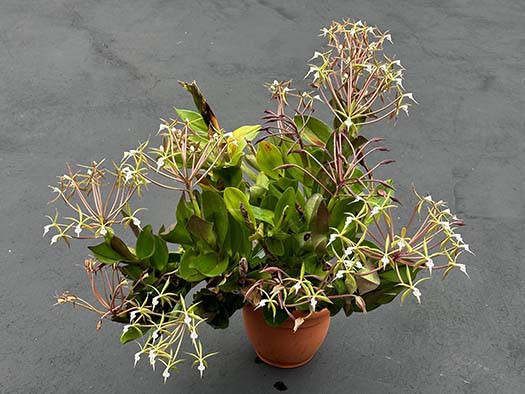
Epidendrum lacustre 'Wow Fireworks' AM/AOS
|
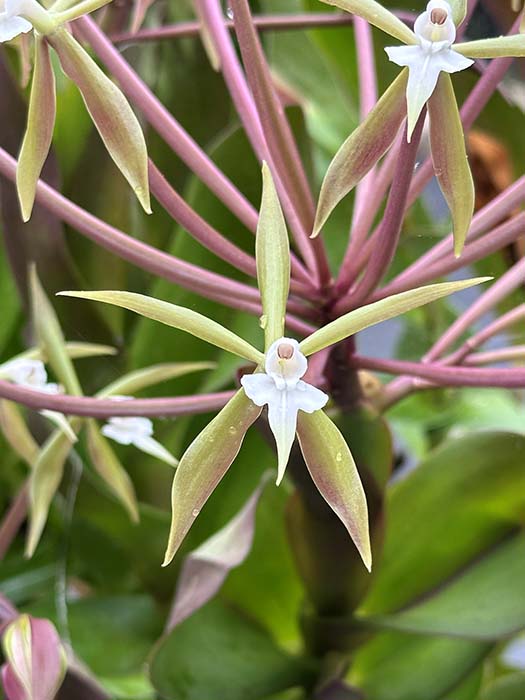 |
Eulophia speciosaThe plant isn’t pretty, but the flowers make up for it, opening sequentially over many months. Grows best potted in sand and in full sun. |
|
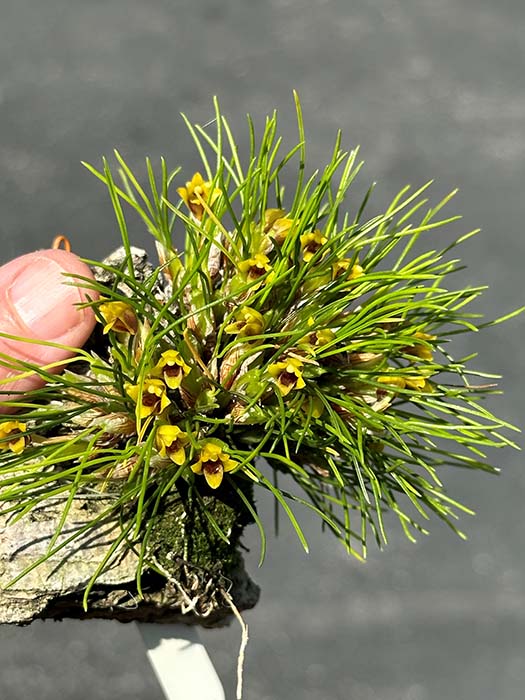 |
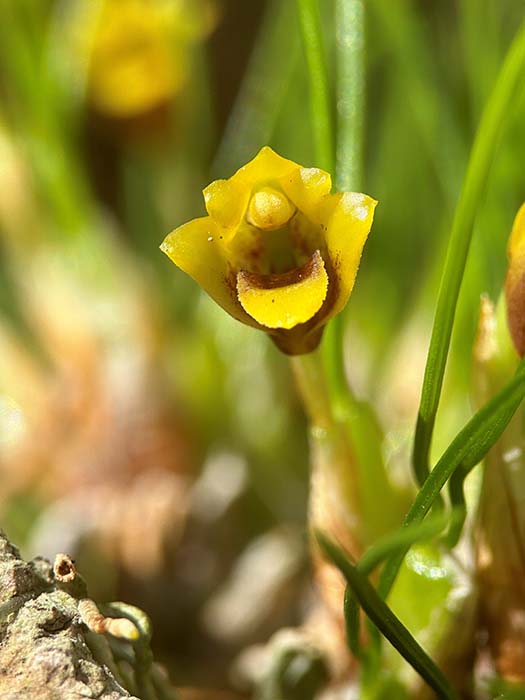 |
Maxillaria (Christensonella) vittelinifloraTiny 1/8” flowers but makes a pretty clump. |
|
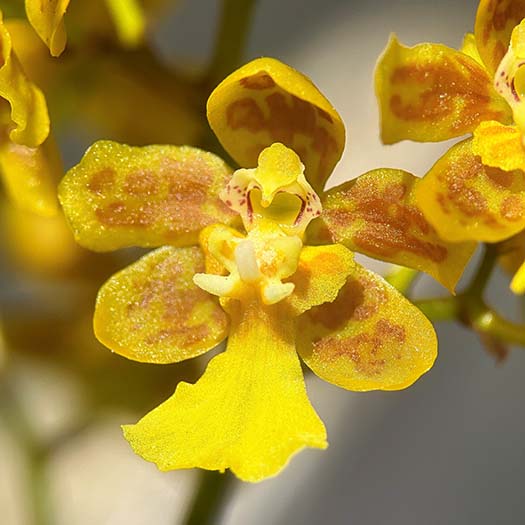
Oncidium harrisonianumSmall (1/4”) but cute flowers, easy grower. |
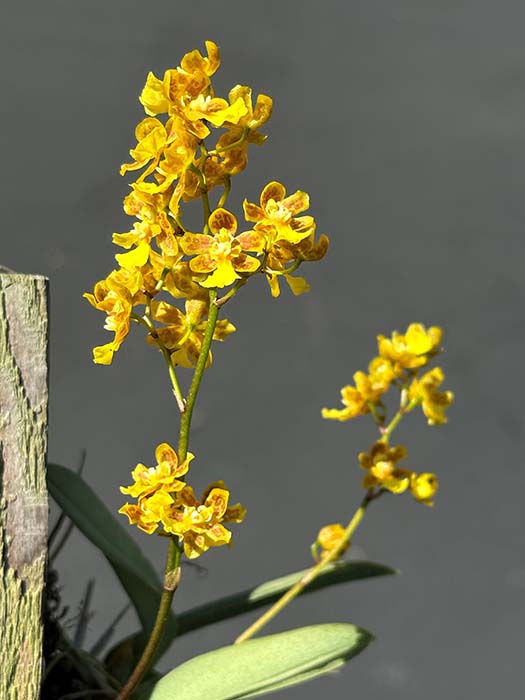 |
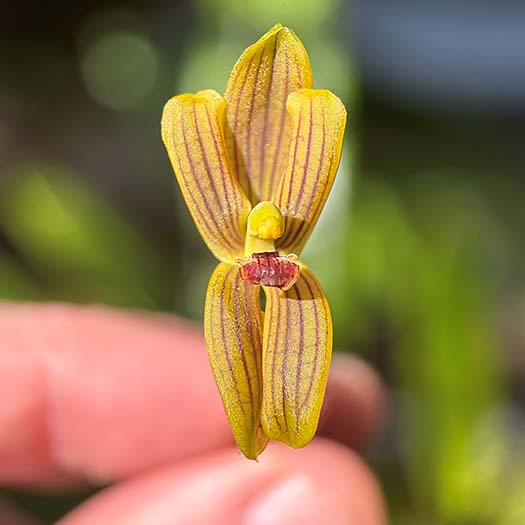 |
Mormolyca ringensSmall (3/4”) flowers on wiry 6” scapes. |
From Roberta Fox:Coastal southern California |
|
Outside in the Back Yard: |
|
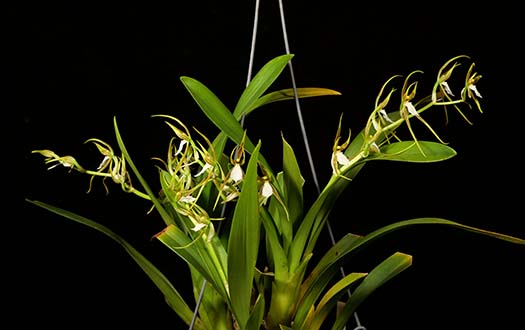 Brassia (Ada) andreetaeNative to Equador, around 1800 m. The big, spidery Brassias are mostly Central American, but Ada from South America has now been lumped into the genus. |
|
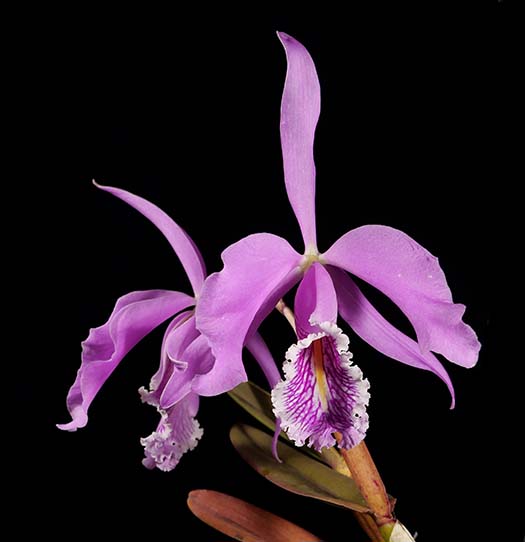
Cattleya maximaOne of the few Cattleya species native to Ecuador (also grows in surrounding countries). This is the highland form, which is cold-tolerant enough to live outside at my house. Plants tend to be smaller than the lowland (warm grownng) forms, and the flowers are smaller as well but have more intense color. And this one is a root machine. |
|

Cattleya schillerianaA fantastic spring for Cattleya species in my back yard. This one is from Brazil (NE and SE), elevations up to 780 m. |
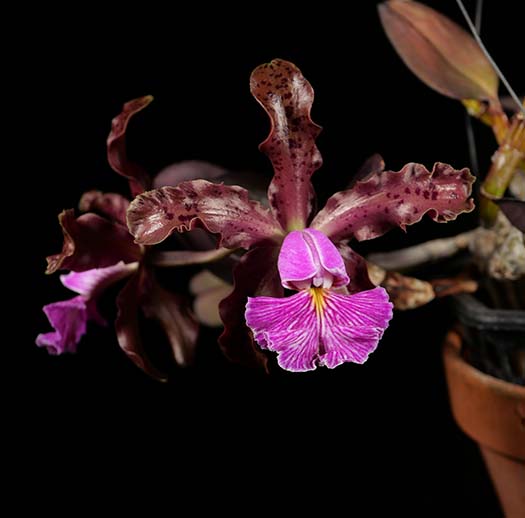 |
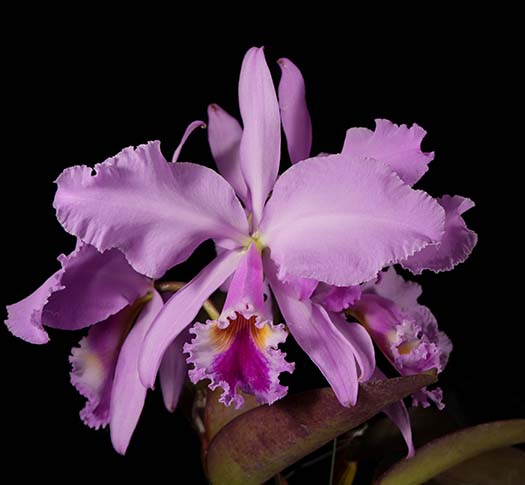
Cattleya warneri5 8-inch flowers on one inflorescence! When I got this, some years back, I grew it i the greenhouse thinking it needed warmth. I later learned that this and the related C. labiata experience chilly nights in habitat, I moved it outside, and it has grown much better. Along with looking spectacular, it is also very fragrant, especially in the morning. |
 |
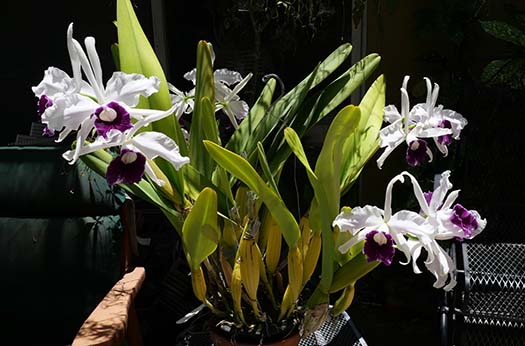
Cattleya (Laelia) purpurata f. schusterianaThe purps are popping! I will save other color forms for next month though they are starting to open now, the purprata show will continue for another 4-6 weeks. This was the first of my C. (L.) purpuratas to bloom, so just an appetizer... |
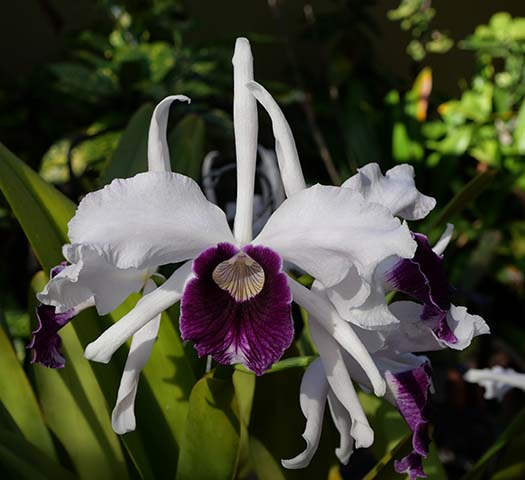 |

Dendrochilum glumaceumNative to Borneo and the Philippines, up to around 2300 m. This one is vigorous, blooms reliably every year. It seems to bloom best when it is a bit potbound, a shallow bulb pan lets it get large without too much volume. |
|
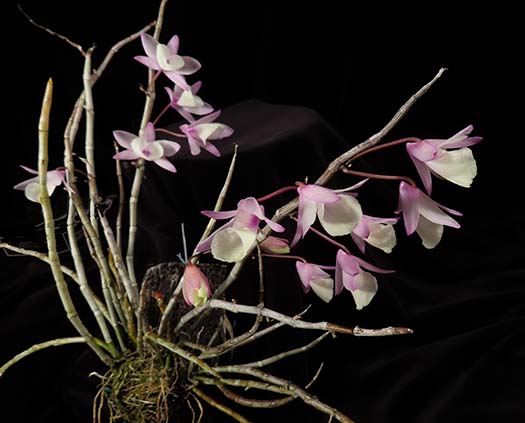
Dendrobium aphyllum v. latifoliumSyn. Den. pierdii. Native to a wide area of Himalaya, SE China, and southeast Asia. Deciduous Dendrobiums continue to bloom for me this month. Leaves are just starting to grow. Flowers appear on bare canes. Like most of these, I don't bother to dry them out in winter and they bloom anyway. |
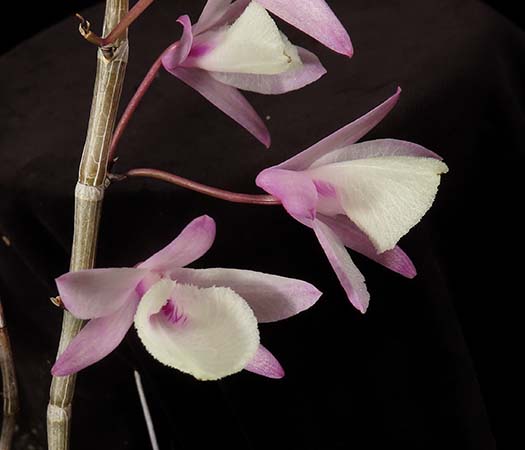 |
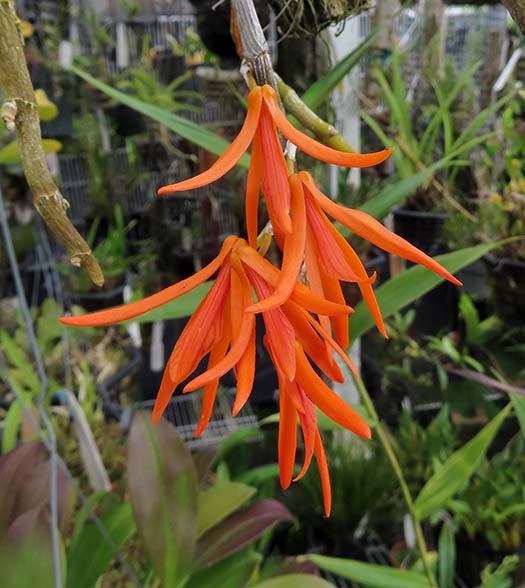 |
|
Dendrobium dickasoniiNo trouble seeing THIS one when it blooms. Long-lasting flowers on bare canes. |
|
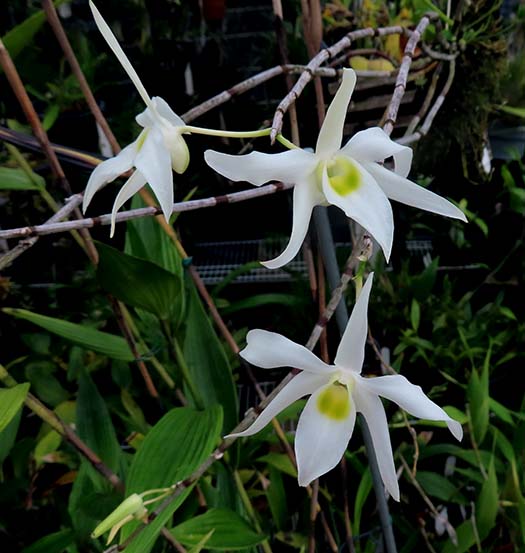
Dendrobium wilsoniiI debated even bothering to show this one, but wanted to relate my sad tale. Four bare canes full of buds, I anticipated a really good show. Came out one morning to find only one cane with flowers, stubs where buds had been, and a small caterpillar munching on one of the open flowers. Dispatching it was very satisfying. Next year... |
|

Dendrobium crepidatumLong lasting flowers have good substance. Each year is better as it gets bigger. New growth just starting to appear. |
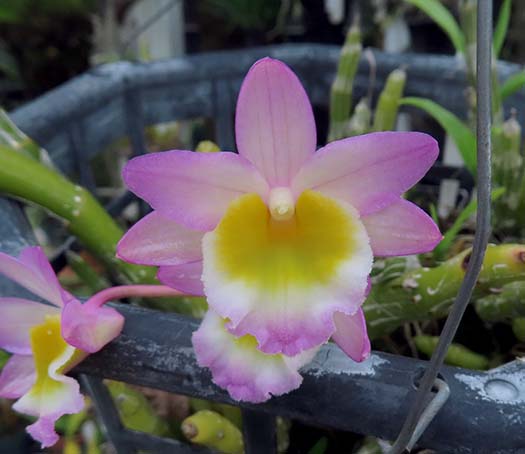 |
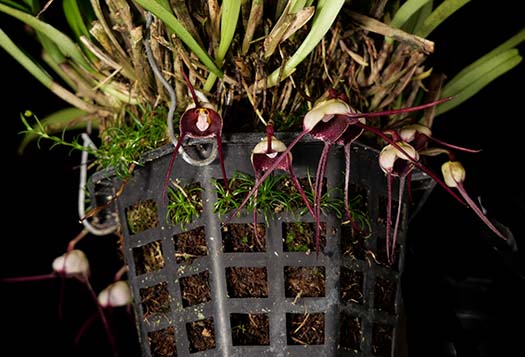
Dracula benedictiiThe flowers emerge from the base of the plant, and mostly stay above the rim of the basket.I have found that I need to pot it well above the rim of the basket, and just barely fitting the plant. These flowers don't collapse during the day, and last for several weeks. . |
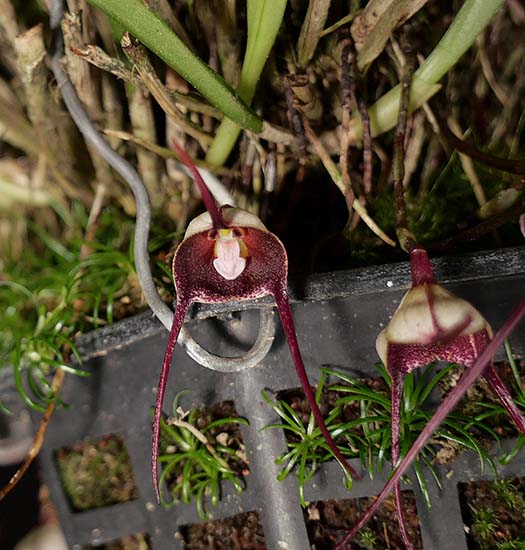 |
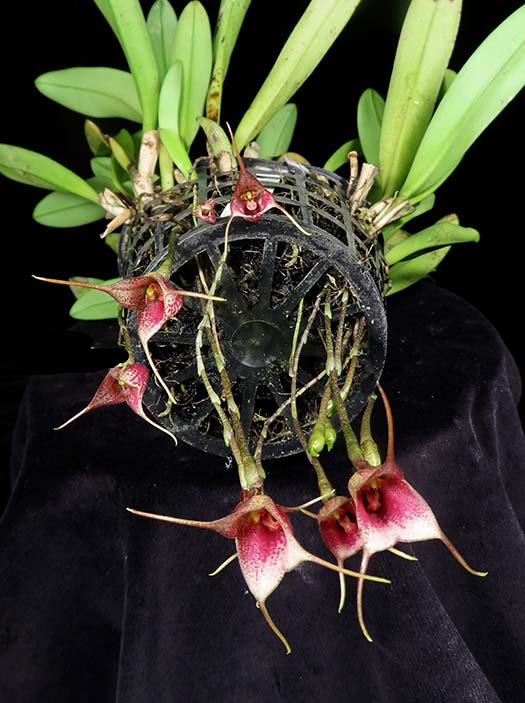 |
|
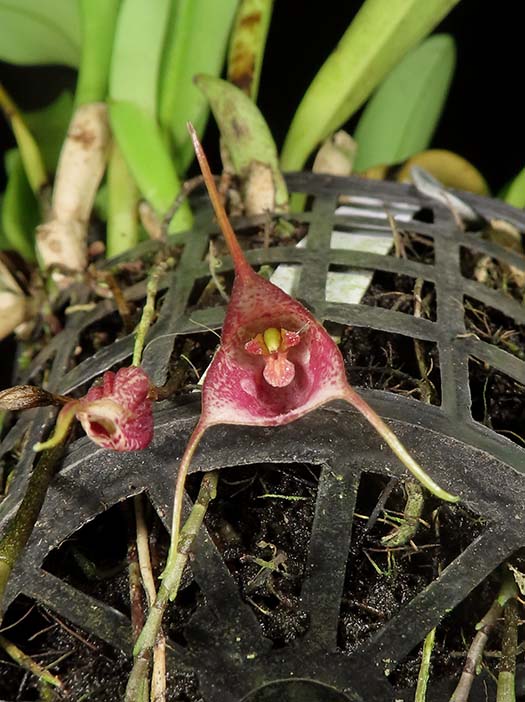 |
|
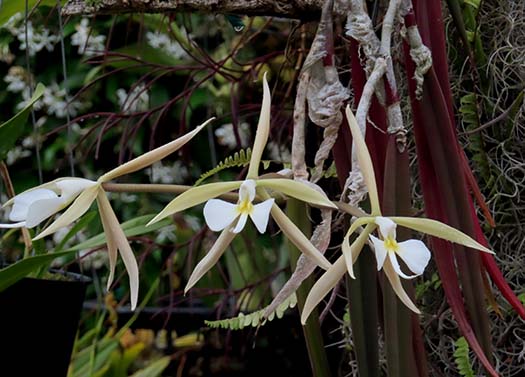
Epidendrum parkinsonianumNight-fragrant flowers. The plant growth is pendant, so needs to be grown mounted or in an inverted basket. Specimens of this can be 6 ft. long. (Mine not so big!) It can root from growths that break off, but the plant is not especially fragile - the stems are very flexible. |
|

Epidendrum falcatumSmaller cousin to Epi. parkinsonianum. Growths are very brittle and tend to be more horizontal than pendant. I no longer even try to move it - every time I do, parts break off. The broken bits do root on a mount, but it's hard to let it grow big.(I suspect that this characteristic is a propagation strategy in the wild.) That fragility causes photographic challenges - the sky and shade cloth and other plants make for a very cluttered background for white flowers. I finally resorted to using flash, at night, to show at least somewhat, the view that I enjoy in person. Without moving it. |
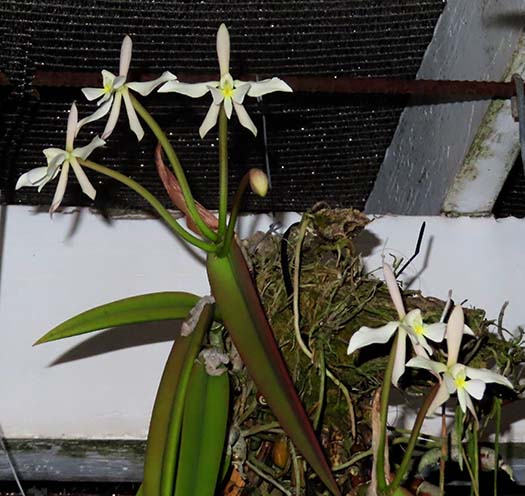 |
 |
|
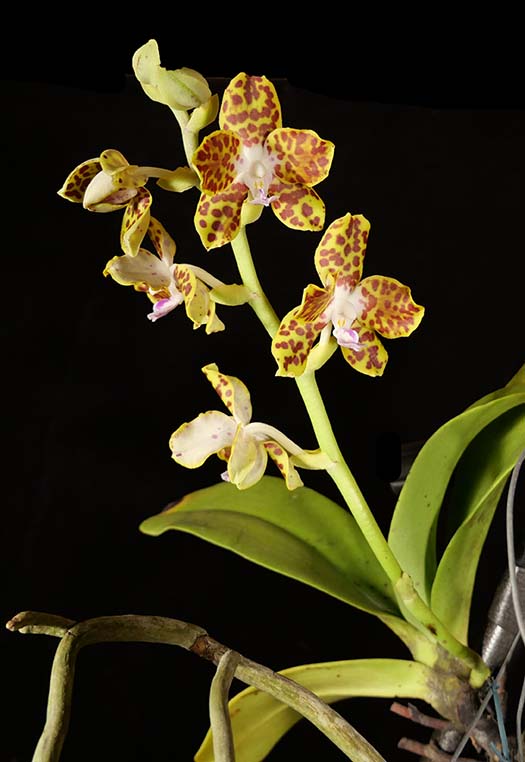 |
|

Phalaenopsis (Sedirea) japonicaAnother monotypic genus that got lumped into Phalaenopsis. As the name implies, it is native to Japan (as well as Korea and China). Citrus-ike fragrance. This small species, crossed with the large Phal. hygrochila, is the primary hybrid Phal. (Vandopirea) Little One, intermediate in size and very fragrant - and also grows easily outside where I live. |
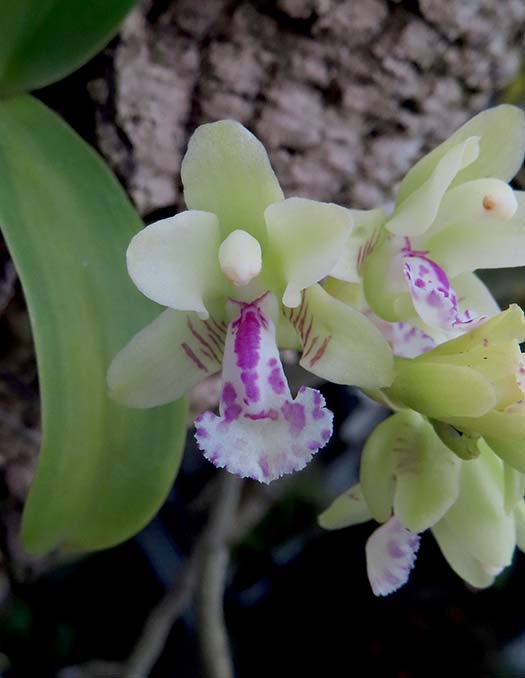 |
 1.jpg)
Symphyglossum sanguineum
|
|
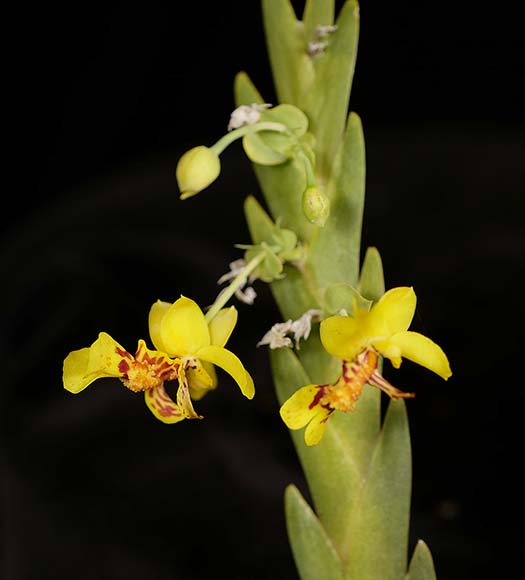 |
|
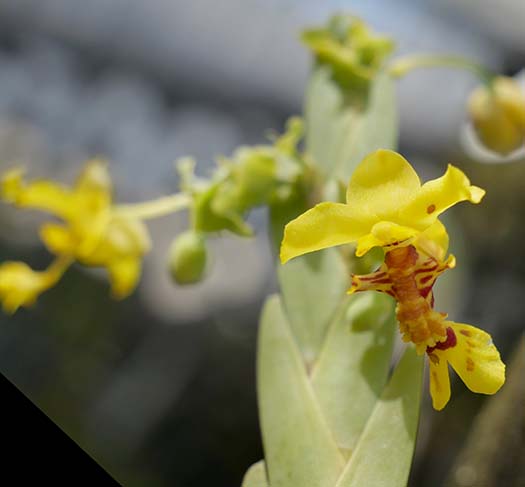 |
|
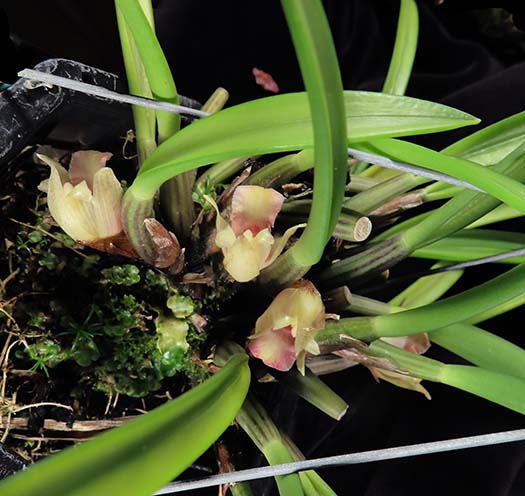
Maxillaria pachyphyllaNot much to look at, but quite fragrant. Leaves are very succulent. Native to S and SE Brazil, and Bolivia, around 400 m. Not much information about the habitat. |
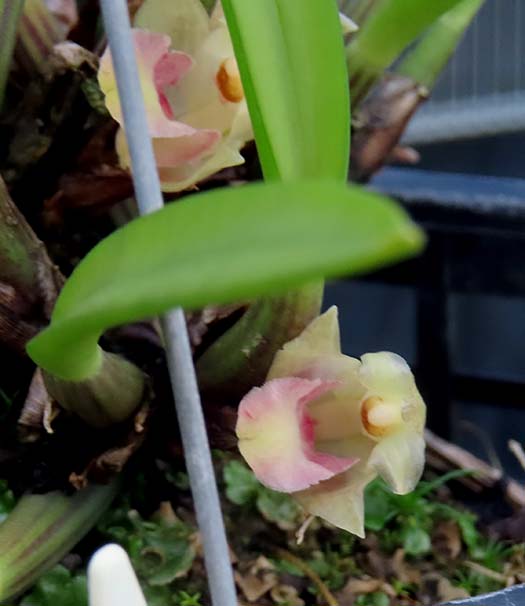 |
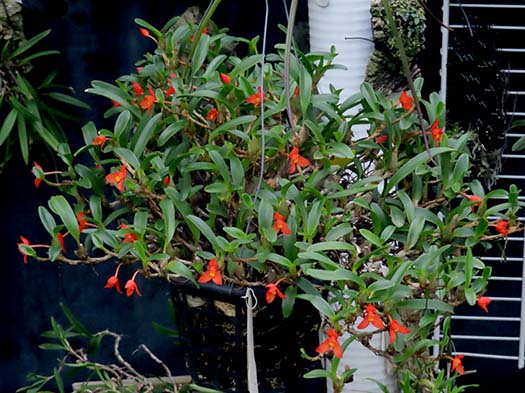
Maxillaria sophronitisBlooms on and off, but two-three times a year produces a spectacular flush bloom. This one brightened up the May gray-June gloom mornings. |
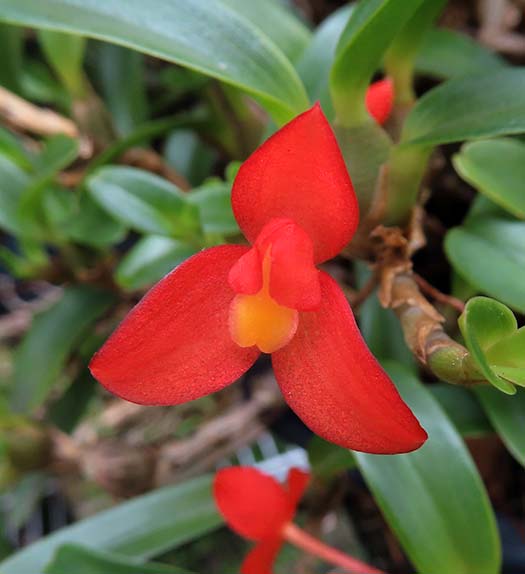 |
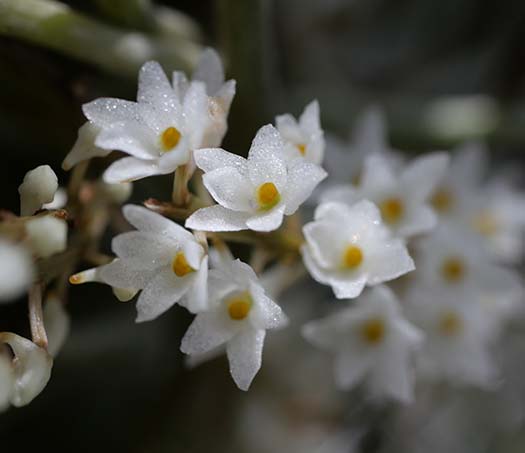 |
|
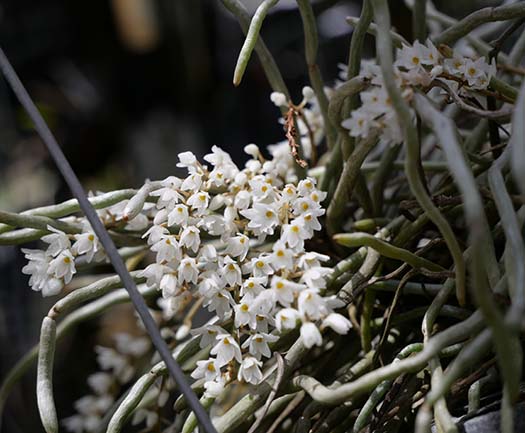 |
|
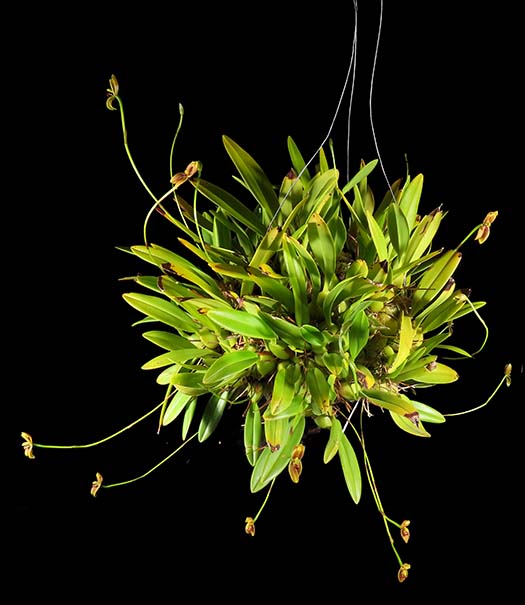
Maxillaria (Mormolyca) ringensIt grows in a dense ball, with pseudobulbs on top of pseudobulbs, almost constantly in bloom. Native to southern Mexico and much of Central America. |
 |
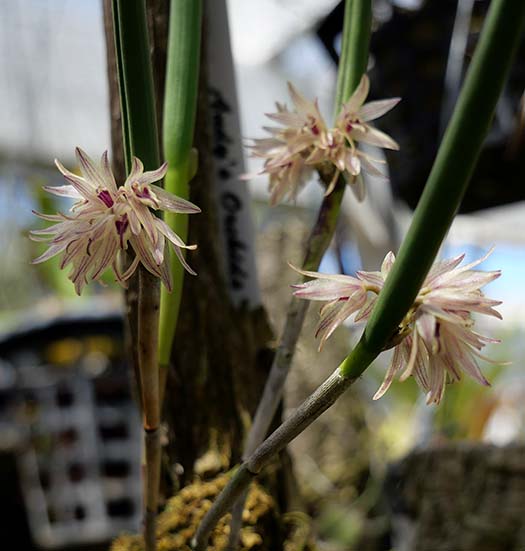 |
|
Octomeria praestansNative to Brazil, S and SE. Note that the flowers emerge from tbase of the leaf where it meets the pseudobulb. Leaves are terete and succulent. Each growth can rebloom multiple times, over 2-3 years. |
|
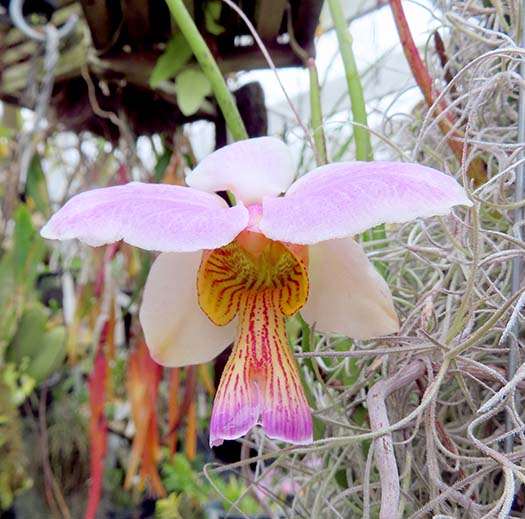
Papilionanthe teresSometimes referred to as a "terete Vanda". Temperature is probably marginal, but it does grow and bloom for me. To help mataintain humidity around the roots, it's surrounded by a nice clump of Tillandsia usenoides (Spanish moss). |
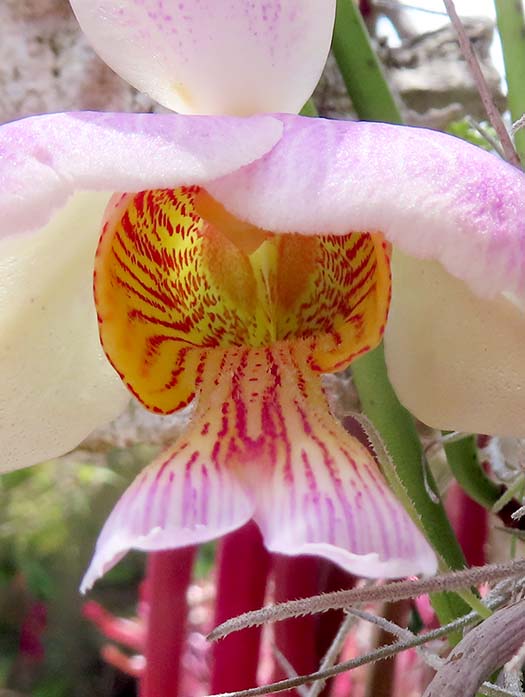 |
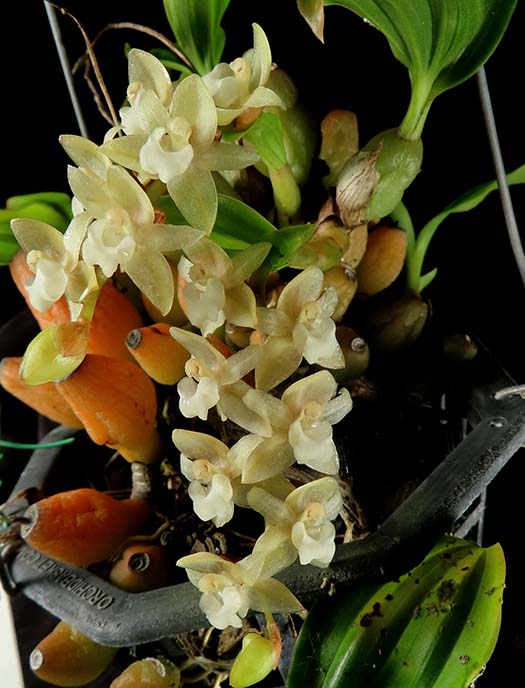
Pholidota chinensisThe geuns Pholidota is a Dendrochilum relative. They're probably all Coelogyne now. |
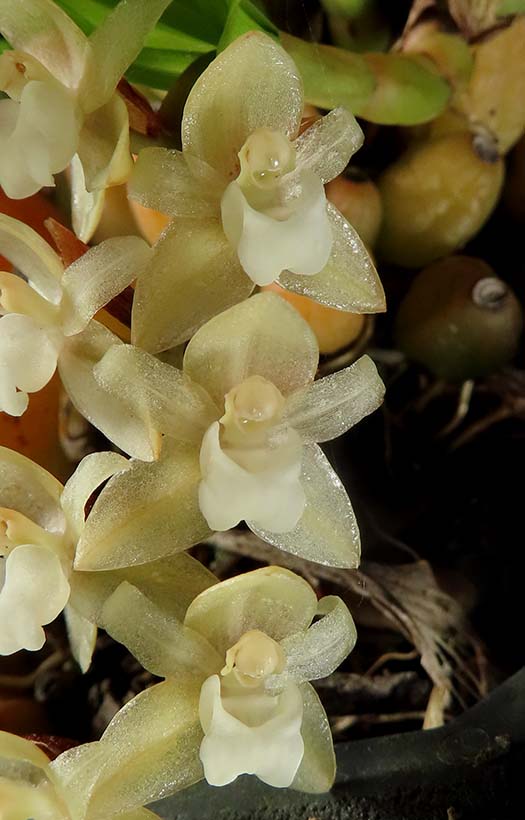 |
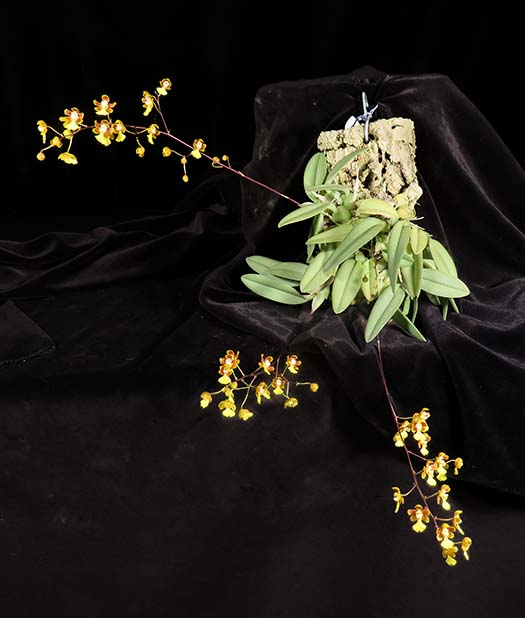 |
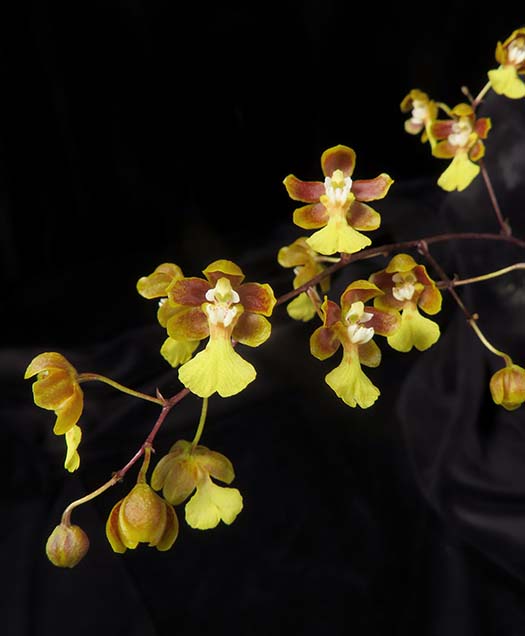 |
Oncidium harrisonianumA very reliable survivor, growing on a bare mount (no moss). Note that mine is a lot darker than Scott's. Color variation within a species is typical, and it's interesting to see them side by side. Native to Brazil SE, elevations up to 1000 m. |
|
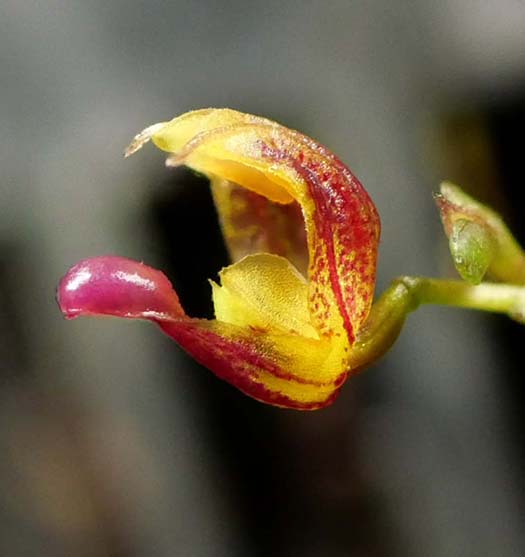
|
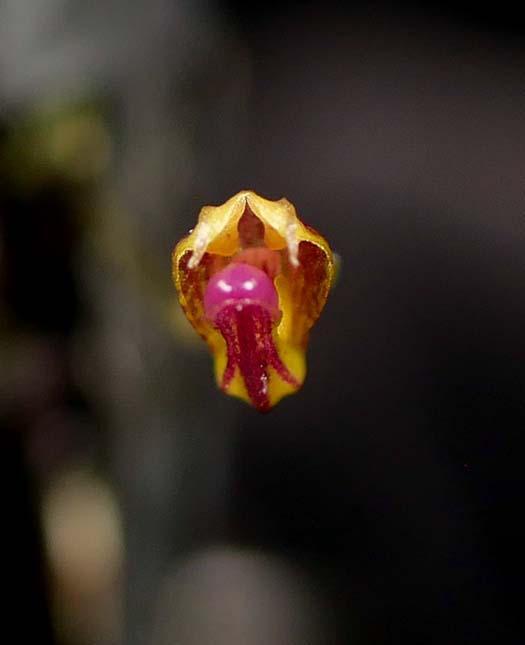 |
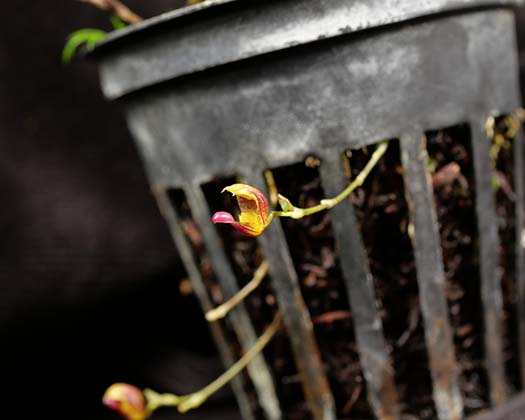
Scaphosepalum sp.This was purchased as Anathallis pachyphyta, but definitely not. Finally got a good enough photo, at a suitable angle, to determine that it is a Scaphosepalum. It is a micro-mini, or really a micro-micro. These adorable flowers are about 2 mm wide, produced sequentially on wire-like inflorescences that can be above the edge of the basket or poking out anywhere below. It's hard to imagine how tiny the pollinator might be! |
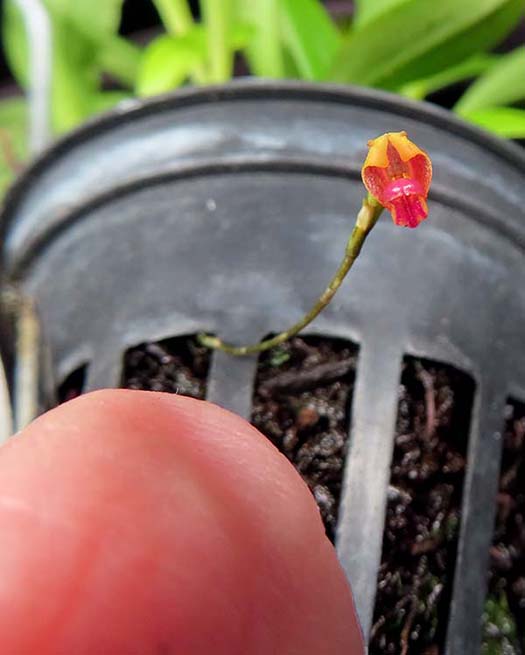 |

Scaphosepalum beluosumAs the plant has gotten larger, it has become extremely floriferous. It can bloom many times on an inflorescence, so they don't get trimmed ever - when they are truly done, they just dry up and drop off. |
 |
 |
|

Scaphosepalum merinoiFlowers look like little birds. |
|
 |
|
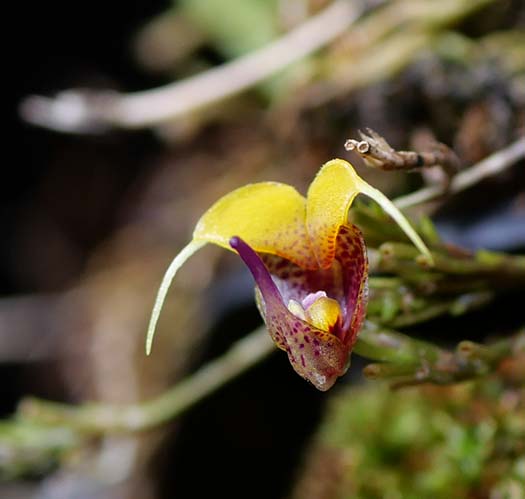
Scaphosepalum swertifolium ssp. exiguumEach species has its own charm. Flowers are very complex, and also quite three-dimensional, making them a challenge to photograph. Almost other-worldly. |
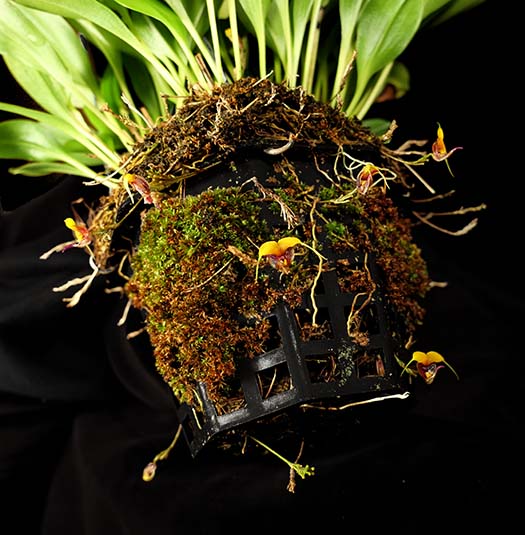 |

Miltonia spectabilis f. albaOther color forms will be blooming in the next month or two. This one was early. |
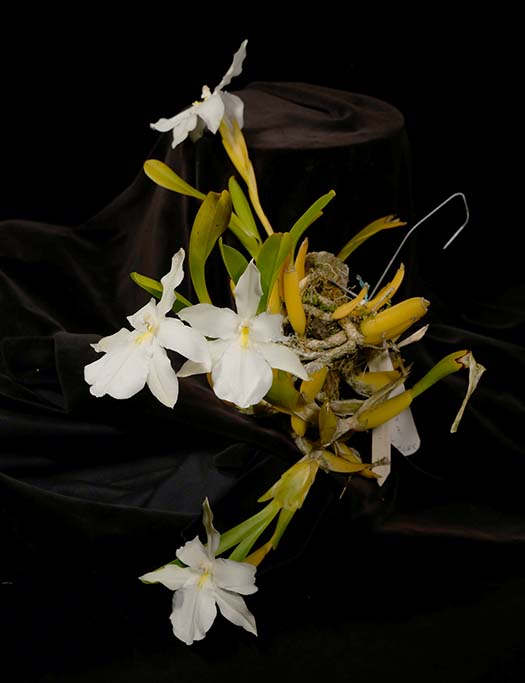 |
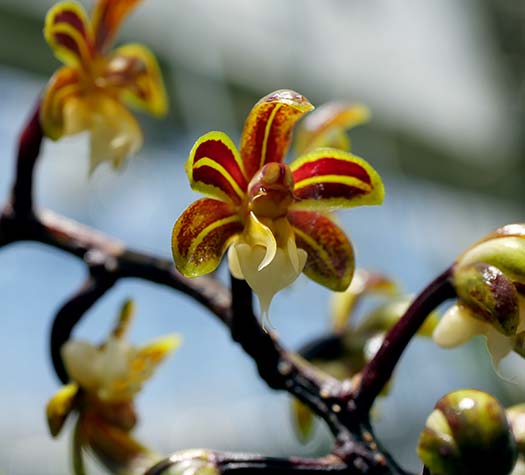
Cleisostoma birmanicumThis little Vandaceous species, from southeast Asia and southern China (elevation 800-1400 m) has been teasing me through most of June. It opened one flower early in the month, then the rest appeared slowly. Still a few buds but it's mostly there, the oldest flowers starting to fade. The chestnut-brown flowers with the inticate details are lovely, it blooms reliably each year. |
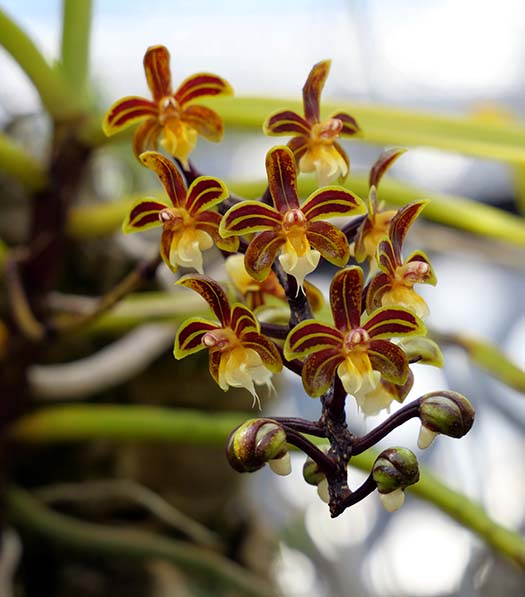 |
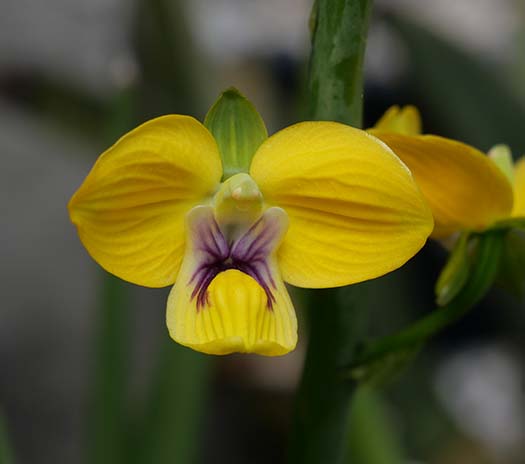
Eulophia speciosaThis African species is just getting started for me. Scott's has been blooming longer, likely because his yard gets more winter sun than mine. I took the opportunity to capture flowers in a compact cluster, and found them with a visitor. Photobombed! This plant will bloom seqauentally all summer, with the spike getting quite long. You'll probably see this again, in 3 months or so, with very long spikes.
|
 |
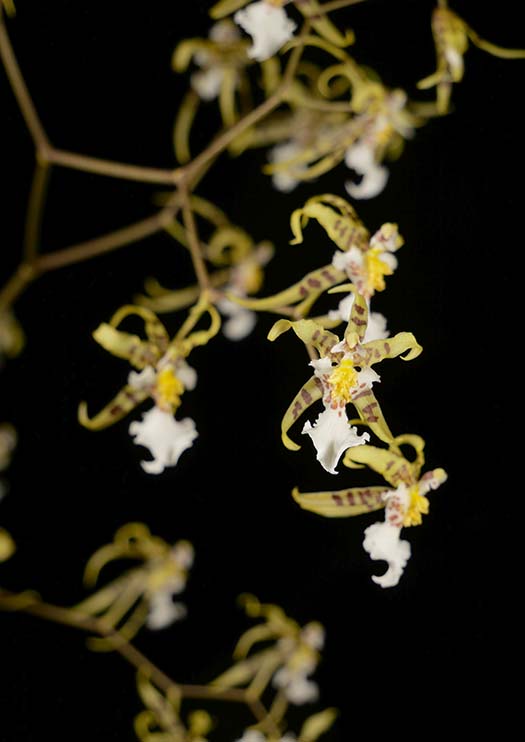
Miltonia phymatochila
|
 |
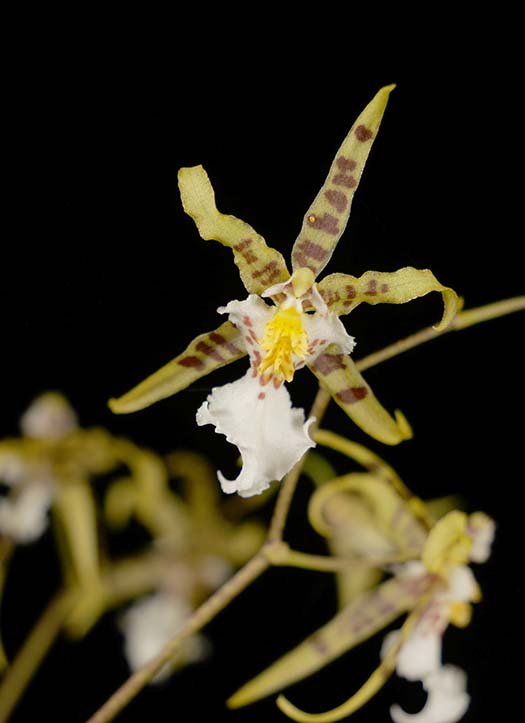 |
|
In the greenhouse... |
|
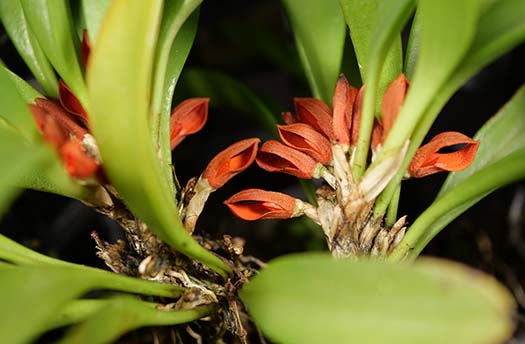 |
|
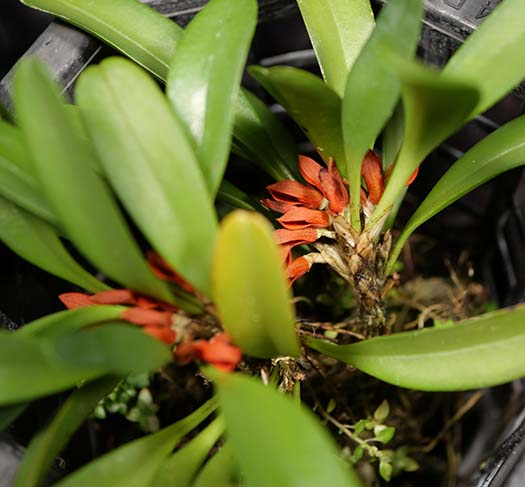 |
|
 Broughtonia sanguineaNative to Jamaica. It has many color forms - red, dark pink, this splash-petal form, aurea, and forms in between. It produces multiple spikes, which continue to produce flowers as the old ones fade. It can stay in bloom for several months. |
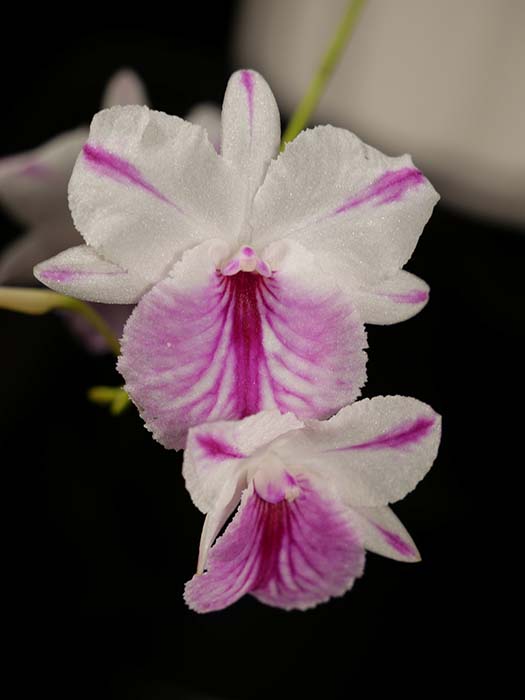 |
From Chris Ehrler:
|
|
California Central Coast |
|
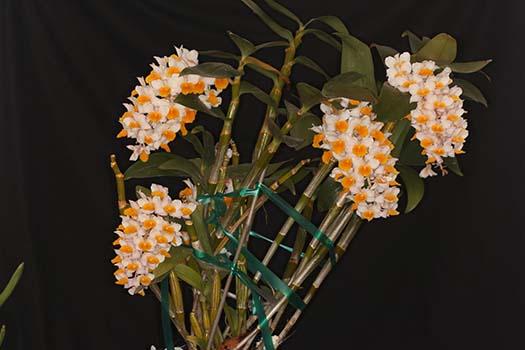 Dendrobium thyrsiflorumNative to the Chinese Himalayas, Hainan China, Assam India, eastern Himalayas, Myanmar, Thailand, Laos, and Vietnam at elevations of 1200 to 2000 meters. Is a cool growing epiphyte, lithophyte, or terrestrial species. This orchid is growing in a plastic pot filled with bark and lava rock with the pot being placed outside under a wood lath cover. This was late blooming for me this year. |
|
 |
|
Dendrochilum cootesiiAcool growing species is endemic to the Philippines growing at elevations around 1,200 to 2,000 meters. This orchid is growing mounted to a piece of wood with a small amount of sphagnum moss on the root. The mount is hanging in a cool greenhouse. |
|
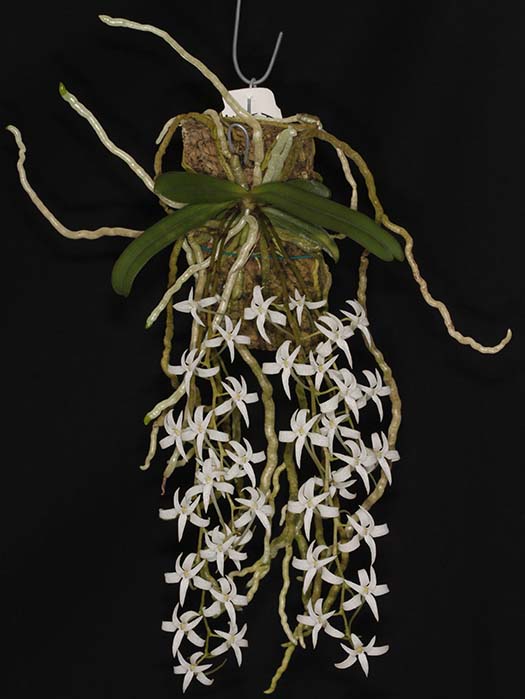
Mystacidium capenseA shade and humidity loving, cool to cold growing epiphyte found at elevations of sea level to 700 meters in South Africa. Generally found growing in deep shady areas. Flowers emit jasmine scent at night. Growing mounted to a small piece of wood which is hanging in a cool greenhouse. |
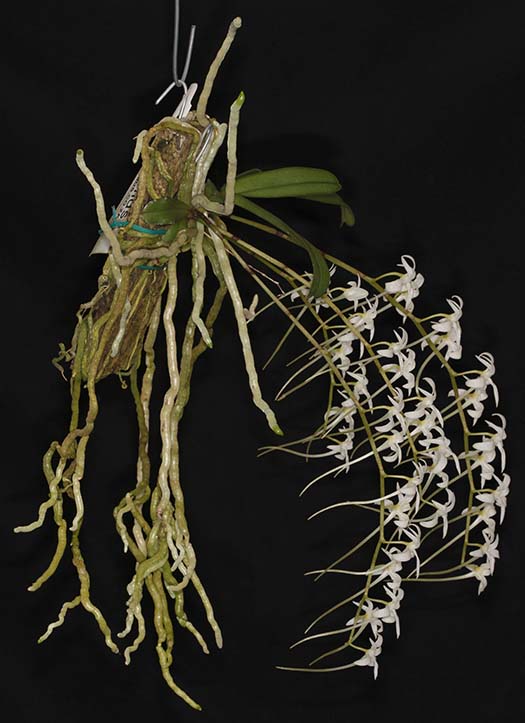 |
 |
|
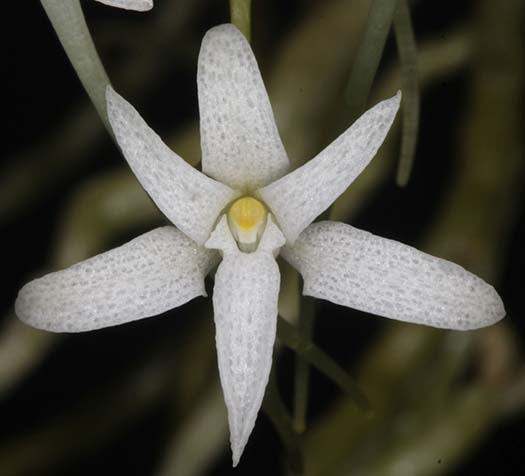 |
|

Scaphosepalum fimbriatumA hot to warm growing epiphyte native to Ecuador at elevations of 750 to 1,200 meters. Growing in aplastic pot filled with a bark and perlite mixture. Was purchased in March 2024 and so far, it is growing well in a cool greenhouse. |
|
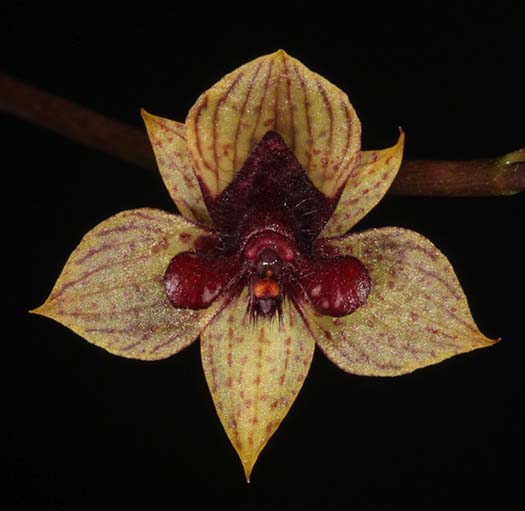
Trichoceros muralisA cool to cold terrestrial growing native in dry rocky regions in Ecuador and Peru at elevations of 2,200 to 3,200 meters. This orchid is growing on a piece of manzanita with most of the plant hanging free of the mount. Mount is hanging in a cool greenhouse. |
 |
From Arnold Markman:
|
|
Intermediate Greenhouse, coastal San Diego area
|
|

Bifreneria (Stenocoryne) aureofulvaIt is from Brazil at 1500 m. Watered daily daily during the warm season and every other day in the winter, western end of greenhouse. |
|
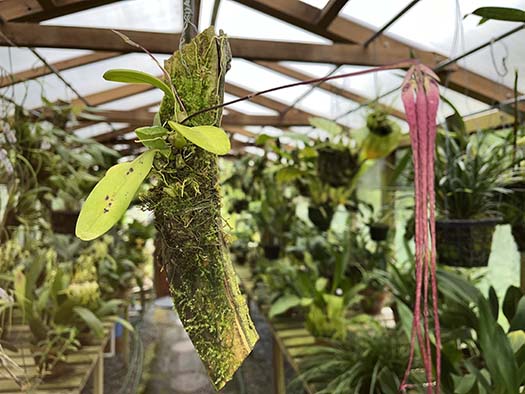
Bulbophyllum treschiiFrom Malaysia and grows between 1000 m and 1500 m. |
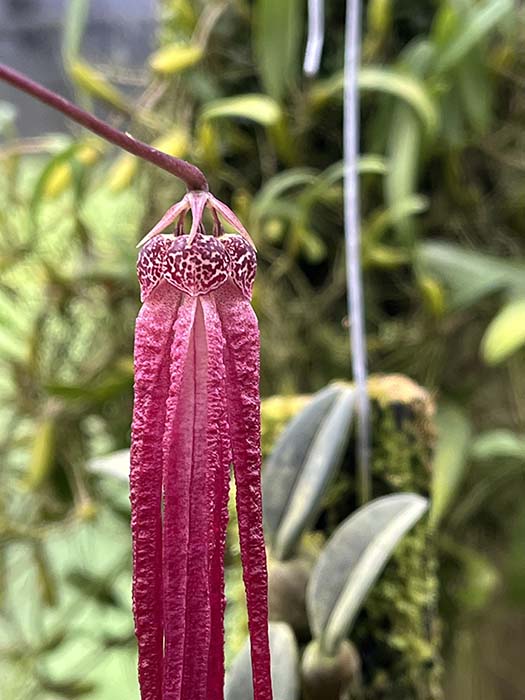 |
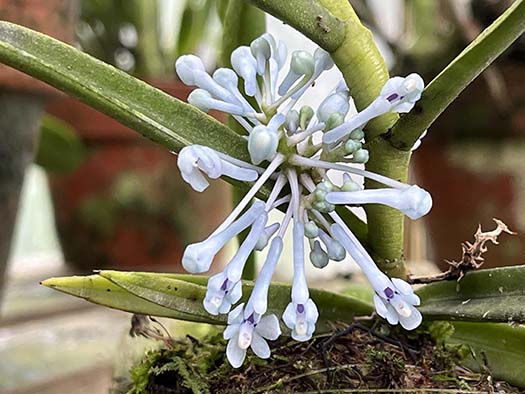
Cleisocentron gokusingiiLabeled Cleisocentron merrilianum, as were many of these sold over the years. From Borneo. (Ed: Cleisocentron merrillianum has terete, pointed leaves. Cleisocentron gokusingii has shorter, semi-terete leaves not as sharply pointed, Flowers look the same for both species.) |
|
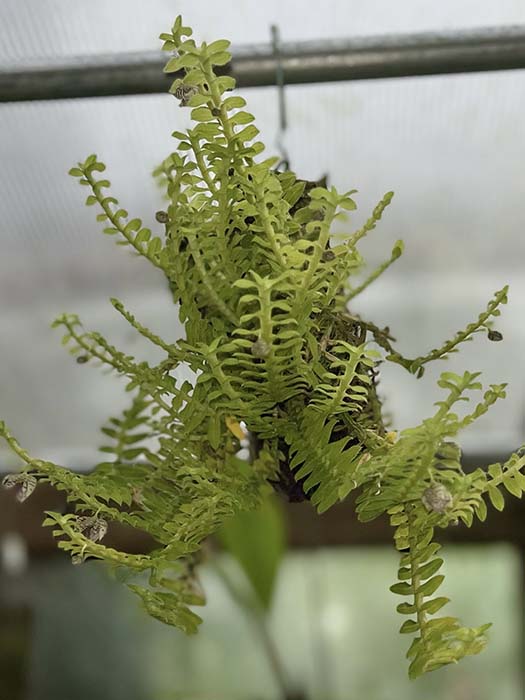 |
|
Dichaea pseudohystricinaA new species, accepted by Kew, published in 2019. Kew indicates that it is from Ecuador. |
|
Dracula chimeraFrom Colombia at about 8000 feet. Grown in the eastern (coolest) part of the greenhouse near ventillation fan. |
|
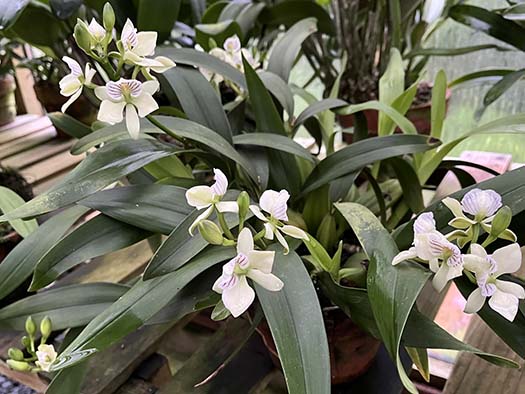
Prosthechea (Encyclia) radiataFrom mixed pine-oak forests in Mexico and grows at altitudes between 150 m to 2000 m. Watered 2-3 tiems per week. |
|
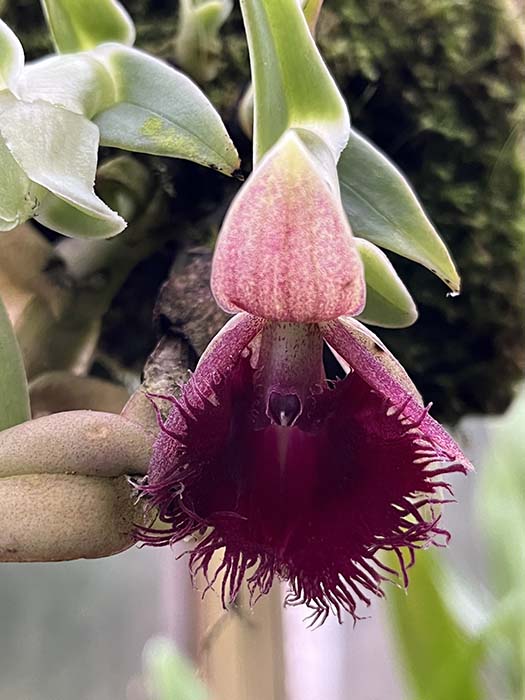 |
|
Epidendrum medusaeIt grows in the high mountains of Ecuador above 6000 feet. Grown in the coolest part of the greenhouse. |
|
 |
|
Isochilus majorFrom montane forests in Mexico. Watered a bit less in winter. |
|
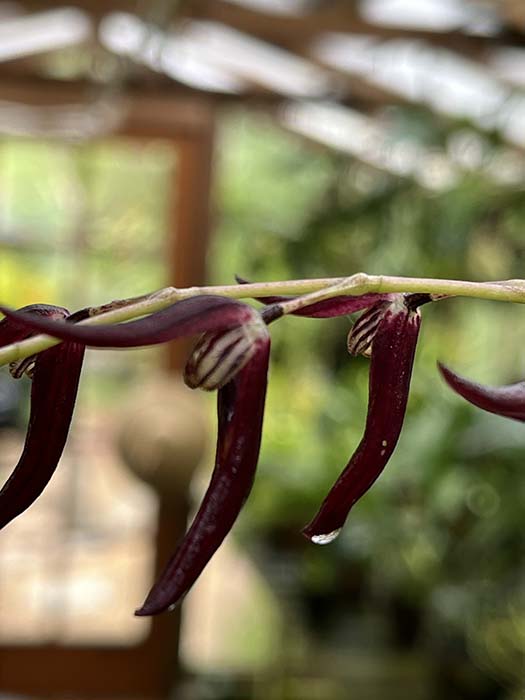 |
|
Pleurothallis (Stelis) tuerckheimiiFrom Central America and grows in mixed oak-pine cloud forests between 700 m and 2400 m. It is nearly always in bloom, now has 6 inflorescences. |
|
 |
|
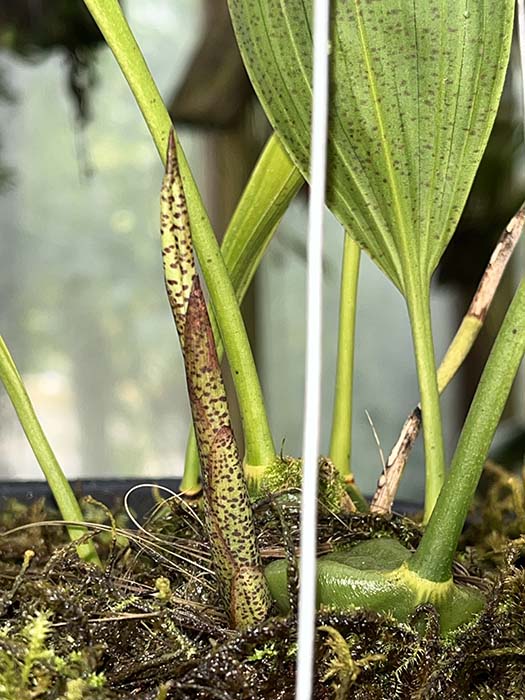 |
|
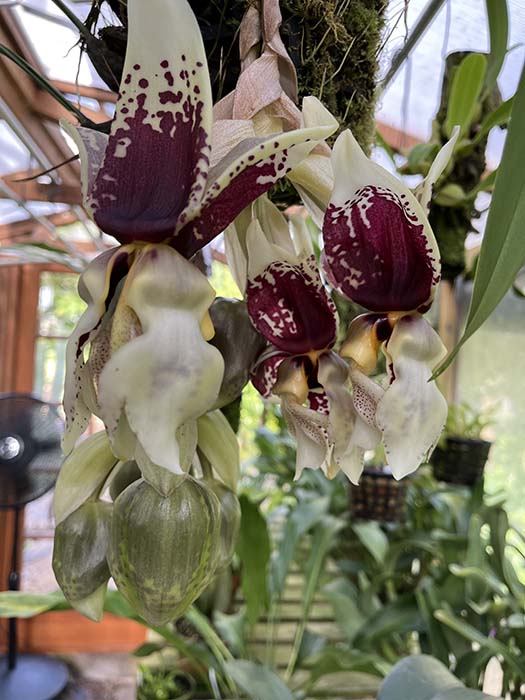
Stanhopea tigrinaThis is an other-worldly flowered plant from Mexico that grows at 1700 m. . I follow Andy Phillips’ suggestion that after I’m done watering my greenhouse I go back and I re-water so is soaked. Nine flowers on this plant! |
 |
 |
|
From Tom Mudge:
|
|
Outdoors, San Francisco peninsula
|
|


